class: right, middle, my-title, title-slide # What is Ecosystem Based <br />Fishery Management? ## University of Maryland MEES 631: Fish Ecology <br /> 27 April 2022 ### Sarah Gaichas<br /> Northeast Fisheries Science Center<br /> <br /> Many thanks to:<br /> Jason Link, NMFS Senior Scientist for Ecosystems <br />Kimberly Bastille, Geret DePiper, Kimberly Hyde, Scott Large, Sean Lucey, Laurel Smith<br /> and all SOE contributors; <br /> Brandon Muffley and all MAFMC Staff <br /> for Risk Assessment updates --- class: top, left <style> p.caption { font-size: 0.6em; } </style> <style> .reduced_opacity { opacity: 0.5; } </style> .center[ # What do *you* think Ecosystem Based Fishery Management (EBFM) means? ] --- # Policy defines EBFM as: ## A systematic approach to fisheries management in a geographically specified area that contributes to the resilience and sustainability of the ecosystem; recognizes the physical, biological, economic, and social interactions among the affected fishery-related components of the ecosystem, including humans; and seeks to optimize benefits among a diverse set of societal goals. .center[ 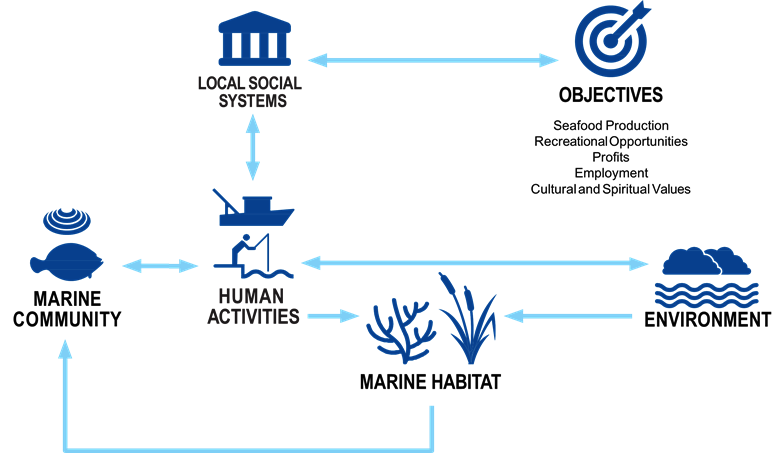 ] .footnote[ https://www.fisheries.noaa.gov/resource/document/ecosystem-based-fisheries-management-policy ] --- .center[  ] .footnote[ https://www.st.nmfs.noaa.gov/Assets/ecosystems/ebfm/EBFM%20Myths%20v7.pdf ] --- ## EBFM Guiding Principles .center[  ] --- # More concrete EBFM--one example and discussion - Evolving ecosystem approach in the Mid-Atlantic *"Can we integrate ecosystem considerations into operational fishery management?"* - Why? - How? Needs to be practical! - What has been done so far? - Discussion *"What should managers do with information on fish ecology?"* - What might be driving observed signals? - How should managers respond, depending on the drivers? - What would you do next? --- ## An integrated ecosystem assessment success story (in progress) Diverse stakeholders agreed that an ecosystem approach was necessary. Developing and implementing an ecosystem approach to fishery management was done in collaboration between managers, stakeholders, and scientists. .pull-left[ *Outline* - Mid-Atlantic Fishery Management Council Ecosystem Approach (EAFM) - Tailoring ecosystem reporting for fishery managers - Mid-Atlantic EAFM risk assessment - Next steps: what would you do? ] .pull-right[ *Integrated Ecosystem Assessment* 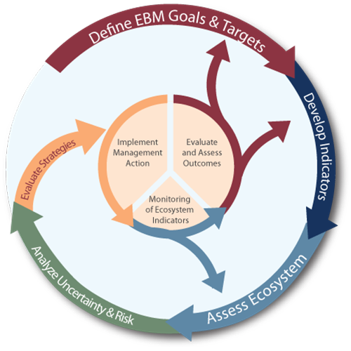 .image-cap[ https://www.integratedecosystemassessment.noaa.gov/national/IEA-approach ] ] ??? --- ## Fishery management in the US Eight regional Fishery Management Councils establish plans for sustainable management of stocks within their jurisdictions. All are governed by the same law, but tailor management to their regional stakeholder needs. .center[  ] More information: http://www.fisherycouncils.org/ https://www.fisheries.noaa.gov/topic/laws-policies#magnuson-stevens-act --- ## The Mid-Atlantic Fishery Management Council (MAFMC) .pull-left-30[  ] .pull-right-70[  ] .footnote[Source: http://www.mafmc.org/fishery-management-plans] --- ## Why an ecosystem approach? *"We rebuilt all the stocks, so why is everyone still pissed off?" --Rich Seagraves* in 2011, the Council asked: .pull-left[  ] .pull-right[  ] And many people answered, from commercial fishery, recreational fishery, environmental organization, and interested public perspectives. Visioning report: http://www.mafmc.org/s/MAFMC-stakeholder-input-report-p7b9.pdf --- ## Common themes among all stakeholder groups: >• There is a lack of confidence in the data that drive fishery management decisions. > >• Stakeholders are not as involved in the Council process as they can and should be. > >• Different jurisdictions and regulations among the many fishery management organizations result in complexity and inconsistency. > >• There is a need for increased transparency and communications in fisheries management. > >• The dynamics of the ecosystem and food web should be considered to a greater extent in fisheries management decisions. > >• Stakeholders are not adequately represented on the Council. > >• Pollution is negatively affecting the health of fish stocks. Visioning report, p. 3: http://www.mafmc.org/s/MAFMC-stakeholder-input-report-p7b9.pdf --- ## How did MAFMC develop their ecosystem approach? Visioning Project → Strategic Plan with one objective to develop >"A non-regulatory umbrella document intended to guide Council policy with respect to ecosystem considerations across existing Fishery Management Plans" .center[  ] Details, including workshop presentations and white papers: http://www.mafmc.org/eafm ??? The Mid-Atlantic Council identified several theme areas from the visioning project as noted in the left panel of the workflow graphic: forage fish, species interactions, social and economic issues, climate and habitat. The Council held full day workshops during Council meetings where experts on the topics provided overviews and Council members asked questions and discussed the issues. Workships on Forage fish, Climate, Climate and Governance, Interactions (species and fleet), and Habitat were held between 2013 and 2015, resulting in white papers on Forage fish, Climate (and habitat), Interactions (species, fleet, climate, and habitat). Social and economic considerations were integrated in each workshop rather than looked at separately. --- ## Mid-Atlantic Council Ecosystem Approach * 2016 Ecosystem Approach to Fishery Management (EAFM) Policy Guidance document: http://www.mafmc.org/s/EAFM-Doc-Revised-2019-02-08.pdf * Mid-Atlantic EAFM framework <a name=cite-gaichas_framework_2016></a>([Gaichas, et al., 2016](https://www.frontiersin.org/articles/10.3389/fmars.2016.00105/full)): .center[ 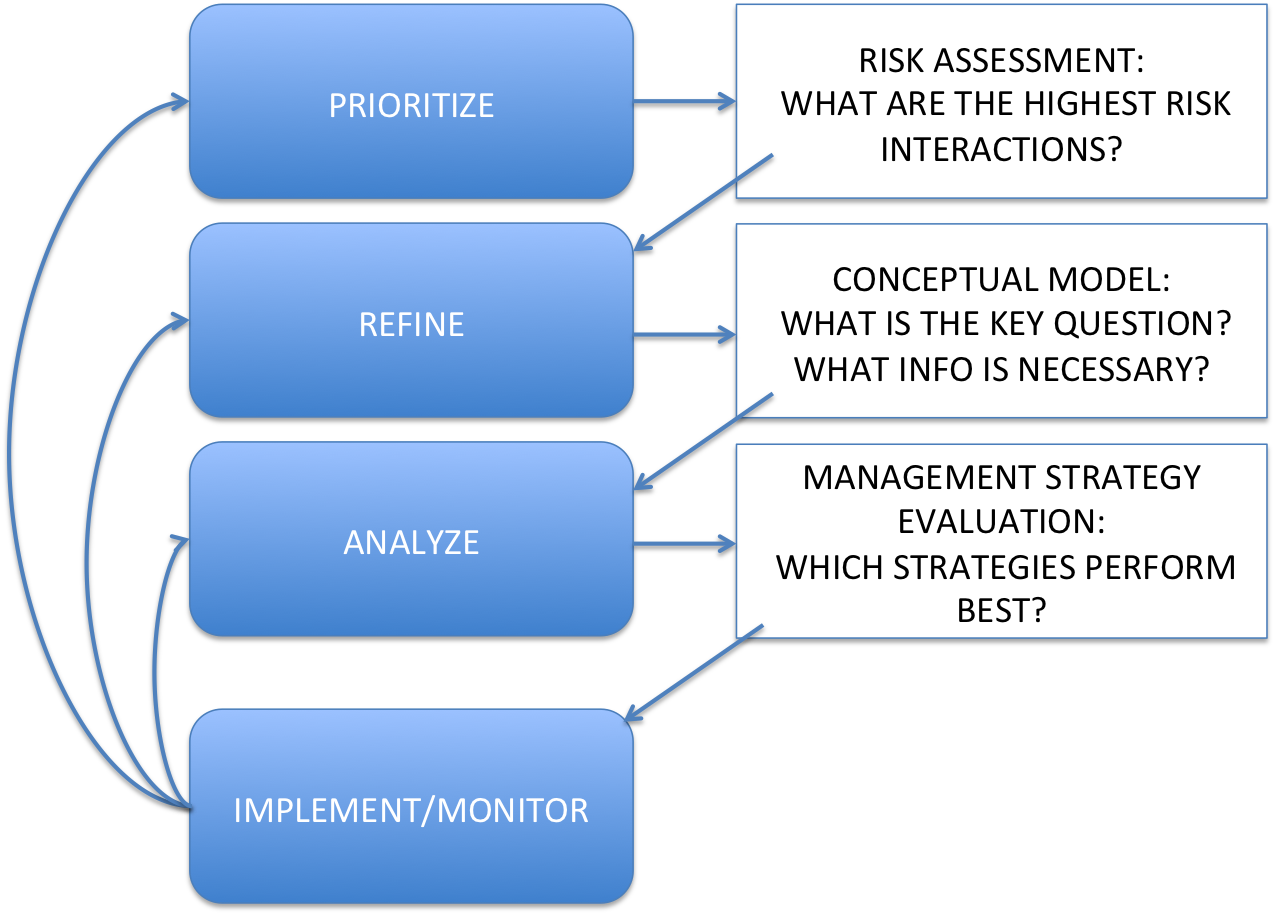 ] ??? The Council’s EAFM framework has similarities to the IEA loop on slide 2. It uses risk assessment as a first step to prioritize combinations of managed species, fleets, and ecosystem interactions for consideration. Second, a conceptual model is developed identifying key environmental, ecological, social, economic, and management linkages for a high-priority fishery. Third, quantitative modeling addressing Council-specified questions and based on interactions identified in the conceptual model is applied to evaluate alternative management strategies that best balance management objectives. As strategies are implemented, outcomes are monitored and the process is adjusted, and/or another priority identified in risk assessment can be addressed. --- # State of the Ecosystem (SOE) reporting ## Improving ecosystem information and synthesis for fishery managers .pull-left-60[ - Ecosystem indicators linked to management objectives <a name=cite-depiper_operationalizing_2017></a>([DePiper, et al., 2017](https://academic.oup.com/icesjms/article/74/8/2076/3094701)) + Contextual information + Report evolving since 2016 + Fishery-relevant subset of full Ecosystem Status Reports - Open science emphasis <a name=cite-bastille_improving_2021></a>([Bastille, et al., 2021](https://doi.org/10.1080/08920753.2021.1846155)) - Used within Mid-Atlantic Fishery Management Council's Ecosystem Process <a name=cite-muffley_there_2021></a>([Muffley, et al., 2021](https://doi.org/10.1080/08920753.2021.1846156)) + Risk assessment <a name=cite-gaichas_implementing_2018></a>([Gaichas, et al., 2018](https://www.frontiersin.org/articles/10.3389/fmars.2018.00442/abstract)) + Conceptual modeling <a name=cite-depiper_learning_2021></a>([DePiper, et al., 2021](https://doi.org/10.1093/icesjms/fsab054)) + Management strategy evaluation (MSE) ] .pull-right-40[ *The IEA Loop*  .footnote[ https://www.integratedecosystemassessment.noaa.gov/national/IEA-approach ] ] ??? --- ## State of the Ecosystem Report Outline .pull-left[ ## 2022 Report Structure 1. Graphical summary + Page 1 report card re: objectives → + Page 2 risk summary bullets + Page 3 synthesis themes 1. Performance relative to management objectives 1. Risks to meeting management objectives Objectives derived from ([DePiper, et al., 2017](https://academic.oup.com/icesjms/article/74/8/2076/3094701)) ] .pull-right[ <table class="table" style="font-size: 14px; margin-left: auto; margin-right: auto;"> <caption style="font-size: initial !important;">Ecosystem-scale fishery management objectives</caption> <thead> <tr> <th style="text-align:left;font-weight: bold;"> Objective Categories </th> <th style="text-align:left;font-weight: bold;"> Indicators reported </th> </tr> </thead> <tbody> <tr grouplength="6"><td colspan="2" style="border-bottom: 1px solid;"><strong>Provisioning and Cultural Services</strong></td></tr> <tr> <td style="text-align:left;padding-left: 2em;" indentlevel="1"> Seafood Production </td> <td style="text-align:left;"> Landings; commercial total and by feeding guild; recreational harvest </td> </tr> <tr> <td style="text-align:left;padding-left: 2em;" indentlevel="1"> Profits </td> <td style="text-align:left;"> Revenue decomposed to price and volume </td> </tr> <tr> <td style="text-align:left;padding-left: 2em;" indentlevel="1"> Recreation </td> <td style="text-align:left;"> Angler trips; recreational fleet diversity </td> </tr> <tr> <td style="text-align:left;padding-left: 2em;" indentlevel="1"> Stability </td> <td style="text-align:left;"> Diversity indices (fishery and ecosystem) </td> </tr> <tr> <td style="text-align:left;padding-left: 2em;" indentlevel="1"> Social & Cultural </td> <td style="text-align:left;"> Community engagement/reliance and environmental justice status </td> </tr> <tr> <td style="text-align:left;padding-left: 2em;" indentlevel="1"> Protected Species </td> <td style="text-align:left;"> Bycatch; population (adult and juvenile) numbers, mortalities </td> </tr> <tr grouplength="4"><td colspan="2" style="border-bottom: 1px solid;"><strong>Supporting and Regulating Services</strong></td></tr> <tr> <td style="text-align:left;padding-left: 2em;" indentlevel="1"> Biomass </td> <td style="text-align:left;"> Biomass or abundance by feeding guild from surveys </td> </tr> <tr> <td style="text-align:left;padding-left: 2em;" indentlevel="1"> Productivity </td> <td style="text-align:left;"> Condition and recruitment of managed species, primary productivity </td> </tr> <tr> <td style="text-align:left;padding-left: 2em;" indentlevel="1"> Trophic structure </td> <td style="text-align:left;"> Relative biomass of feeding guilds, zooplankton </td> </tr> <tr> <td style="text-align:left;padding-left: 2em;" indentlevel="1"> Habitat </td> <td style="text-align:left;"> Estuarine and offshore habitat conditions </td> </tr> </tbody> </table> ] --- ## Ecosystem synthesis themes Characterizing ecosystem change for fishery management * Societal, biological, physical and chemical factors comprise the **multiple system drivers** that influence marine ecosystems through a variety of different pathways. * Changes in the multiple drivers can lead to **regime shifts** — large, abrupt and persistent changes in the structure and function of an ecosystem. * Regime shifts and changes in how the multiple system drivers interact can result in **ecosystem reorganization** as species and humans respond and adapt to the new environment. .pull-left[ 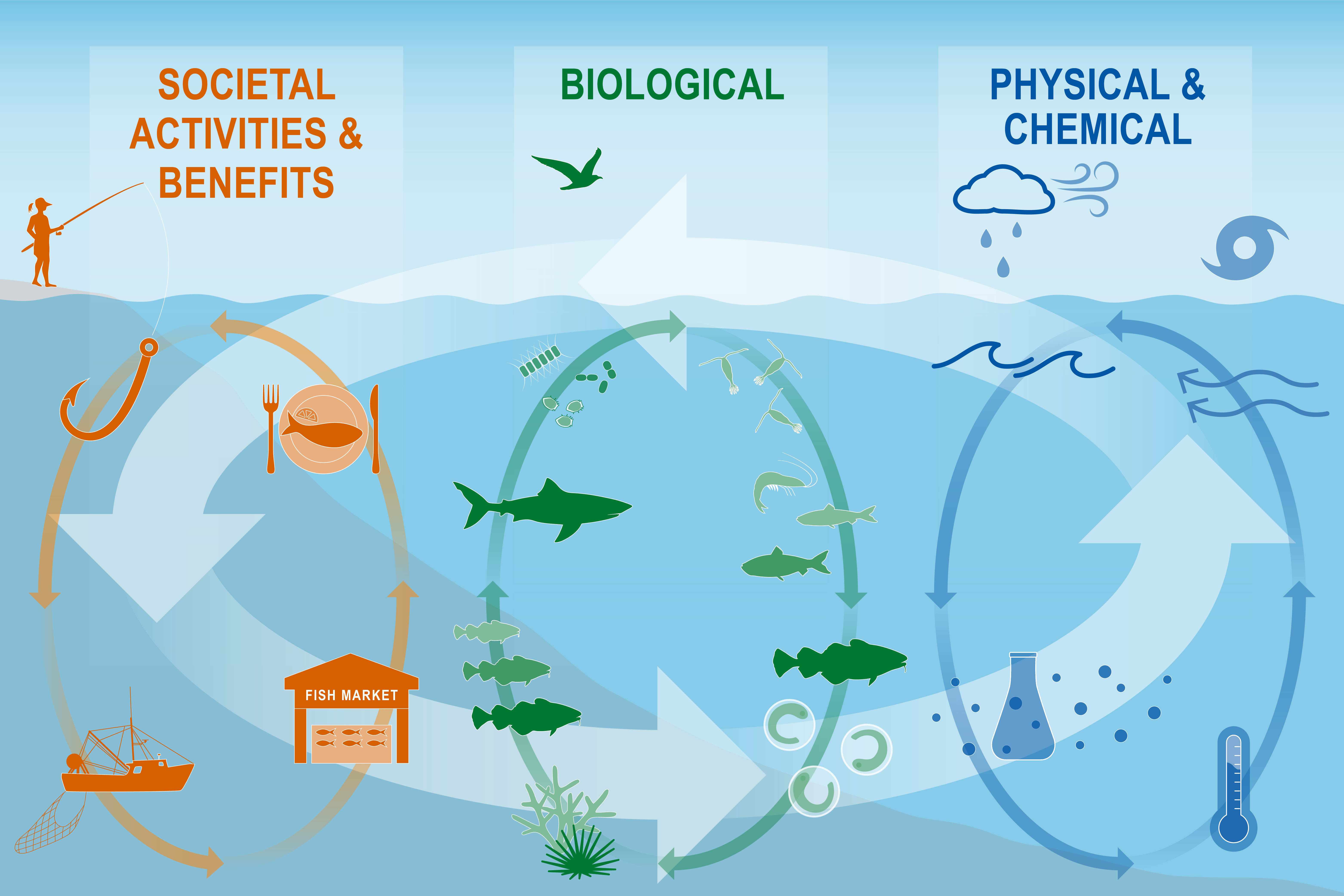 ] .pull-right[ 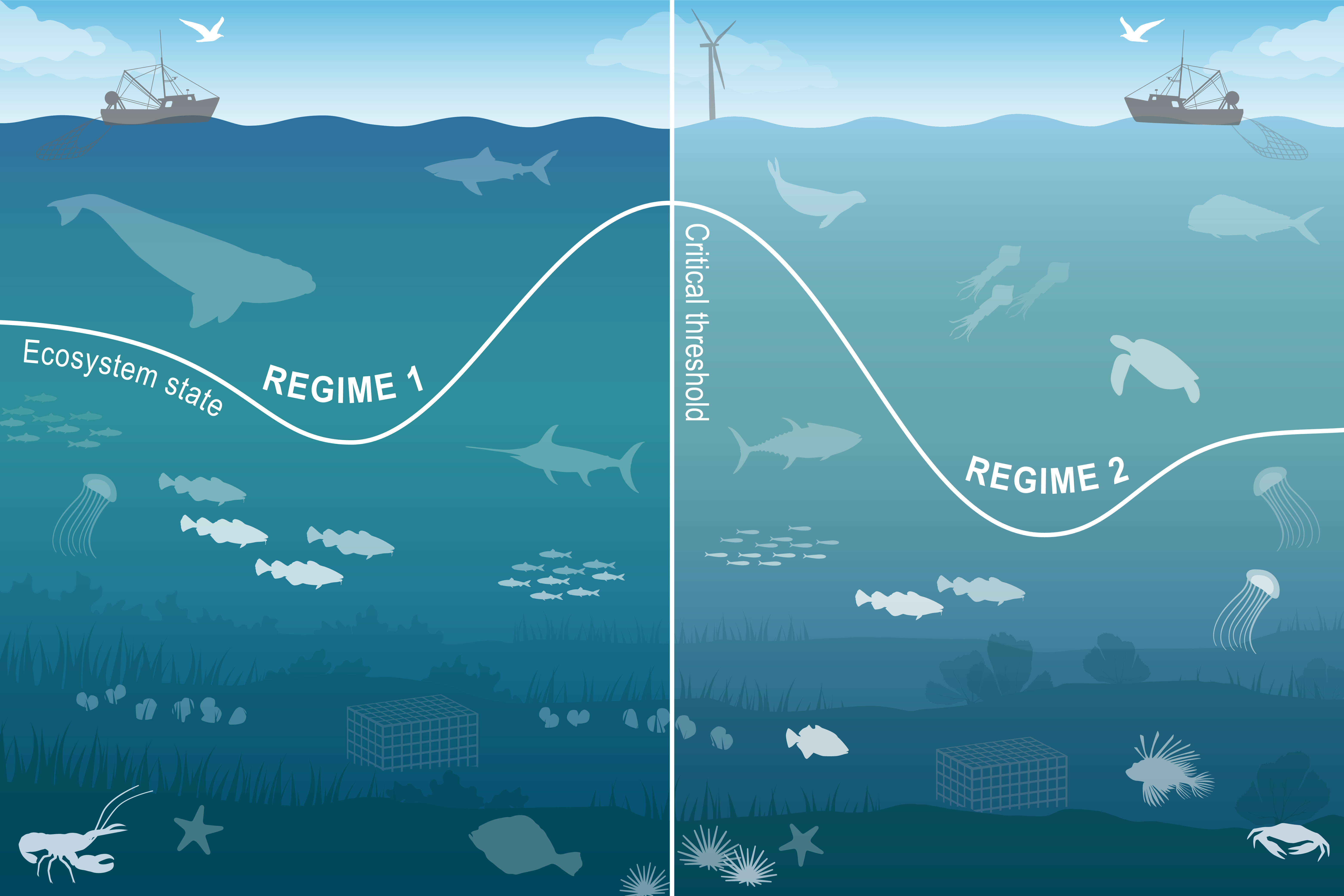 ] --- ## State of the Ecosystem report scale and figures .pull-left[ Spatial scale 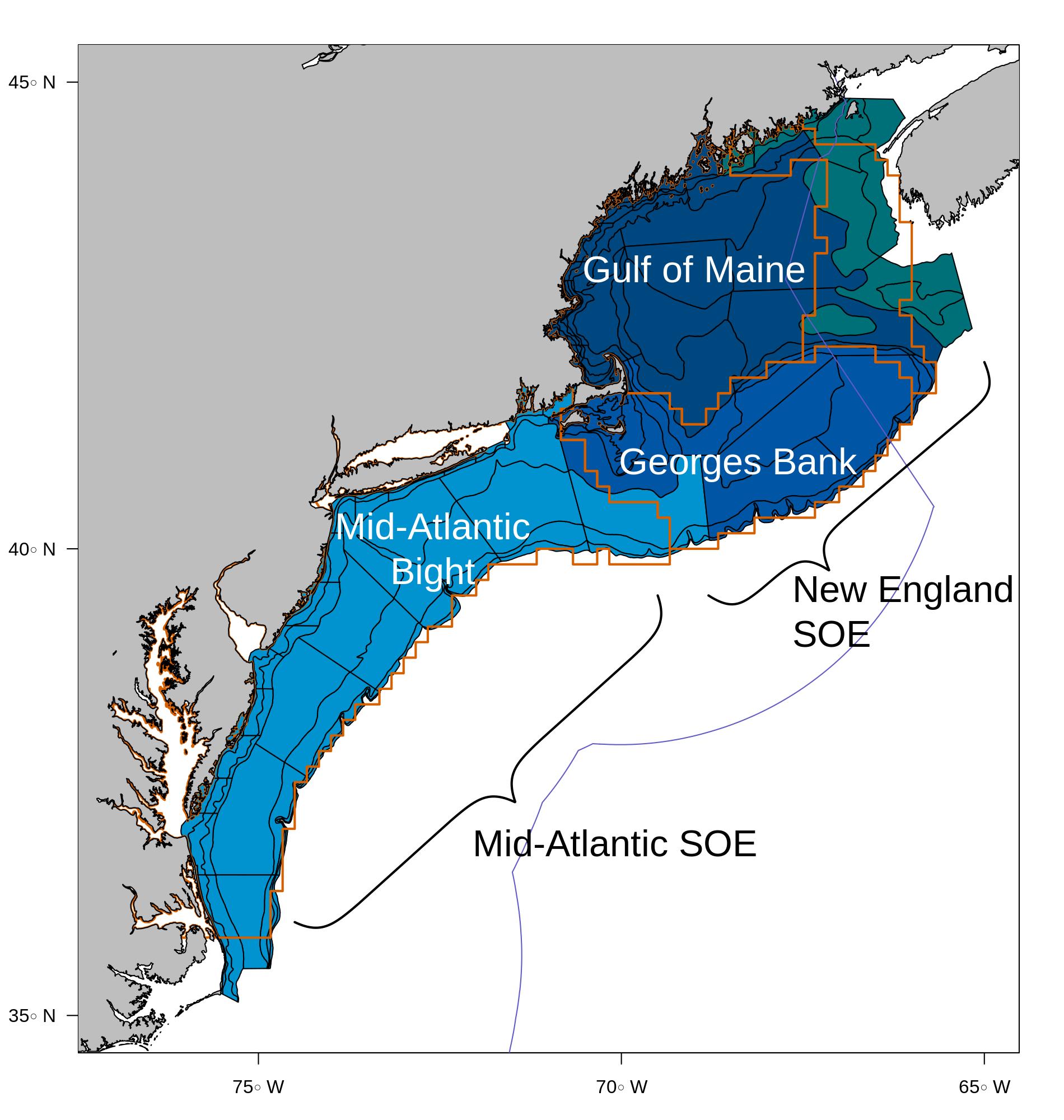 A [glossary of terms](https://noaa-edab.github.io/tech-doc/glossary.html) (2021 Memo 5), detailed [technical methods documentation](https://NOAA-EDAB.github.io/tech-doc) and [indicator data](https://github.com/NOAA-EDAB/ecodata) are available online. ] .pull-right[ Key to figures <img src="20220427_UM_MEES631_Gaichas_files/figure-html/unnamed-chunk-5-1.png" width="396" style="display: block; margin: auto;" /> .contrib[ Trends assessed only for 30+ years: [more information](https://noaa-edab.github.io/tech-doc/trend-analysis.html) <p style="color:#FF8C00;">Orange line = significant increase</p> <p style="color:#9932CC;">Purple line = significant decrease</p> No color line = not significant or < 30 years <p style="background-color:#D3D3D3;">Grey background = last 10 years</p> ] ] --- background-image: url("EDAB_images/SOE-MA-final-03.23.22-no marks_Page_2.png") background-size: 500px background-position: right ## State of the Ecosystem Summary 2022: **Performance relative to management objectives** .pull-left-60[ Seafood production , status not evaluated Profits , status not evaluated Recreational opportunities: Effort  ; Effort diversity   Stability: Fishery  ; Ecological   Social and cultural, trend not evaluated, status of: * Fishing engagement and reliance by community * Environmental Justice (EJ) Vulnerability by community Protected species: * Maintain bycatch below thresholds   * Recover endangered populations (NARW)   ] .pull-right-40[] --- background-image: url("EDAB_images/SOE-MA-final-03.23.22-no marks_Page_3.png") background-size: 500px background-position: right ## State of the Ecosystem Summary 2022: **Risks to meeting fishery management objectives** .pull-left-60[ Climate: warming and changing oceanography continue * Heat waves and Gulf Stream instability * Estuarine, coastal, and offshore habitats affected, with range of species responses * Below average summer 2021 phytoplankton * Multiple fish with poor condition, declining productivity Other ocean uses: offshore wind development * Current revenue in proposed areas - 1-31% by port (some with EJ concerns) - 0-20% by managed species * Different development impacts for species preferring soft bottom vs. hard bottom * Overlap with one of the only known right whale foraging habitats, increased vessel strike and noise risks * Rapid buildout in patchwork of areas * Scientific survey mitigation required ] .pull-right-40[] --- ## State of the Ecosystem → MAFMC Risk assessent example: Commercial revenue This element is applied at the ecosystem level. Revenue serves as a proxy for commercial profits. .table[ .pull-left[ <table> <thead> <tr> <th style="text-align:left;"> Risk Level </th> <th style="text-align:left;"> Definition </th> </tr> </thead> <tbody> <tr> <td style="text-align:left;width: 20em; "> Low </td> <td style="text-align:left;width: 20em; "> No trend and low variability in revenue </td> </tr> <tr> <td style="text-align:left;width: 20em; "> Low-Moderate </td> <td style="text-align:left;width: 20em; "> Increasing or high variability in revenue </td> </tr> <tr> <td style="text-align:left;width: 20em; font-weight: bold;background-color: orange !important;"> Moderate-High </td> <td style="text-align:left;width: 20em; font-weight: bold;background-color: orange !important;"> Significant long term revenue decrease </td> </tr> <tr> <td style="text-align:left;width: 20em; "> High </td> <td style="text-align:left;width: 20em; "> Significant recent decrease in revenue </td> </tr> </tbody> </table> Ranked moderate-high risk due to the significant long term revenue decrease for Mid-Atlantic managed species (red points in top plot) ] ] .pull-right[ <img src="20220427_UM_MEES631_Gaichas_files/figure-html/unnamed-chunk-6-1.png" width="504" style="display: block; margin: auto;" /> Key: Black = Revenue of all species combined; <p style="color:#FF6A6A;">Red = Revenue of MAFMC managed species</p> ] -- ## Risk element: <span style="background-color:orange;">CommRev</span>, unchanged **SOE Implications:** Recent change driven by benthos. Monitor changes in climate and landings drivers: - Climate risk element: <span style="background-color:orange;">Surfclams</span> and <span style="background-color:red;">ocean quahogs</span> are sensitive to ocean warming and acidification. - pH in surfclam summer habitat is approaching, but not yet at, pH affecting surfclam growth --- # Performance relative to management objectives .center[ 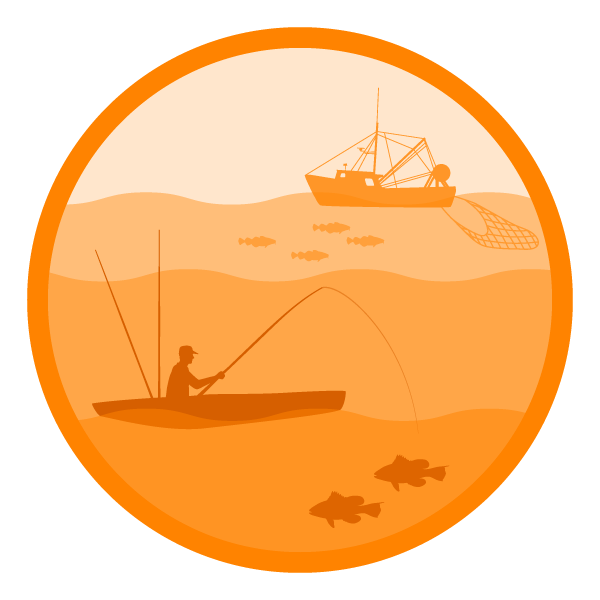 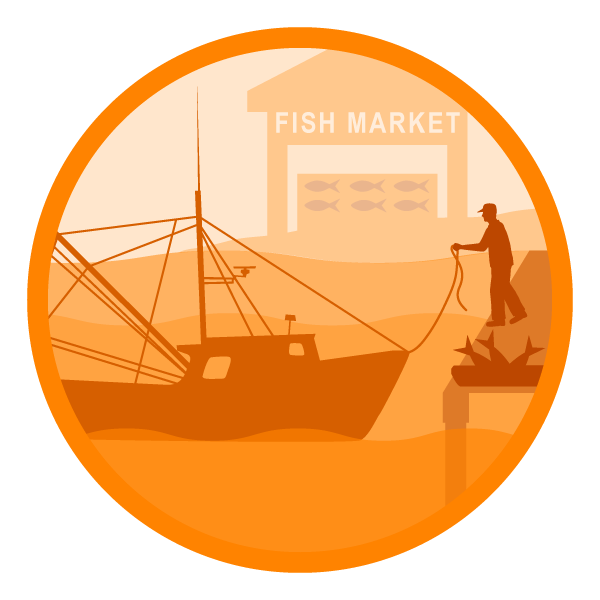 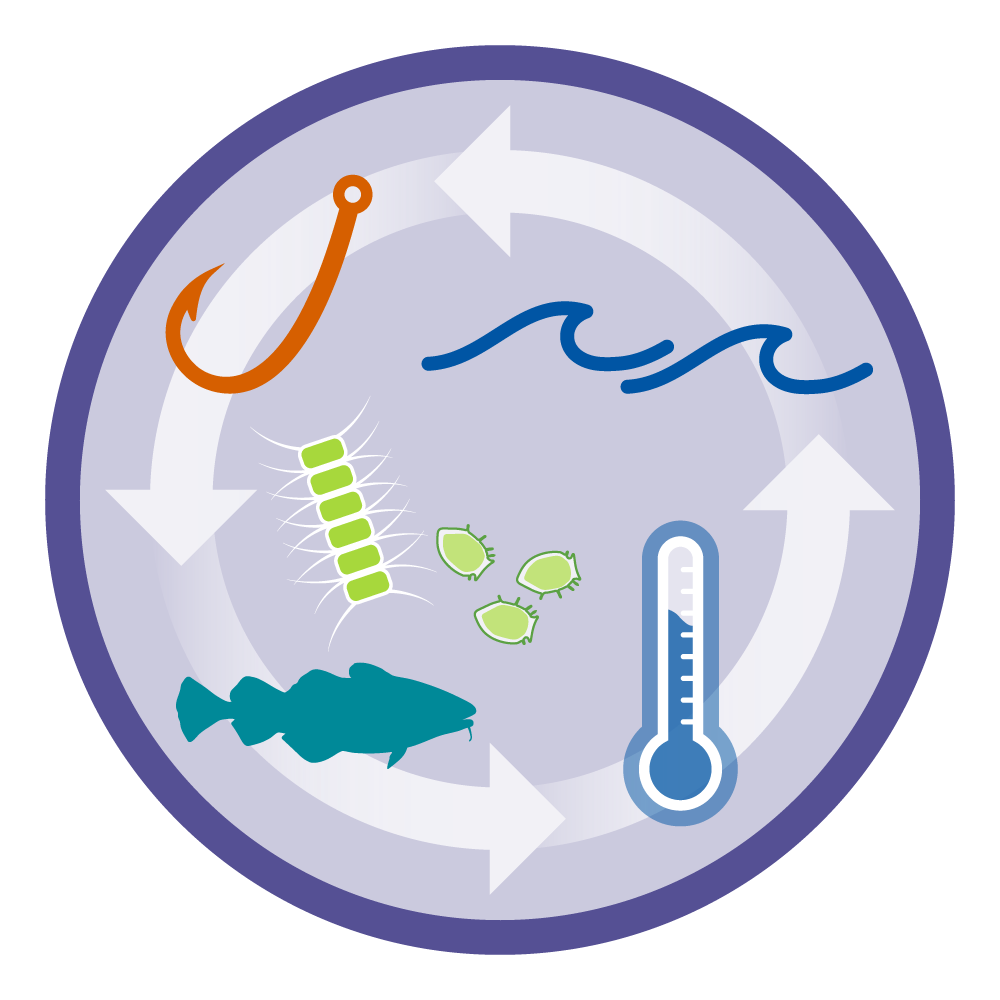 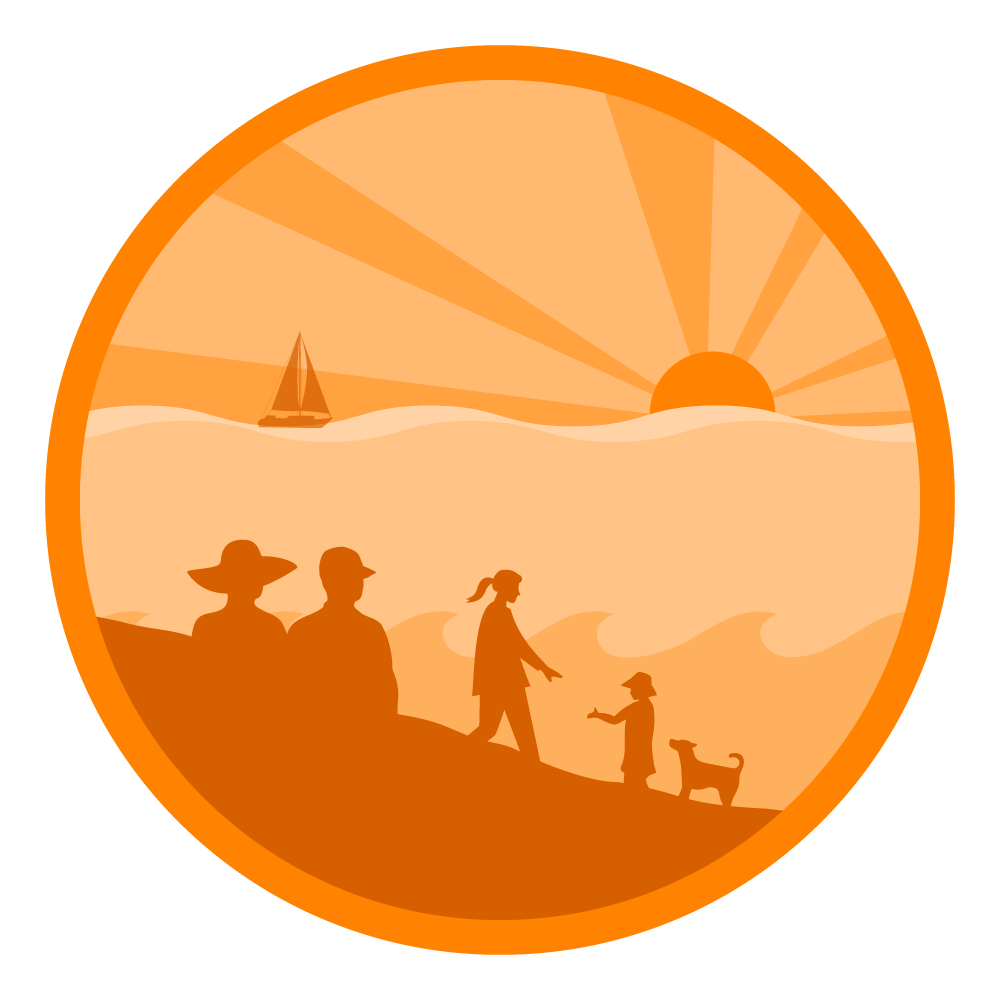  ] --- ## Objective: Seafood production    Risk elements: <span style="background-color:red;">ComFood</span> and <span style="background-color:orange;">RecFood</span>, unchanged .pull-left[ Indicator: Commercial landings .reduced_opacity[ <img src="20220427_UM_MEES631_Gaichas_files/figure-html/unnamed-chunk-7-1.png" width="504" style="display: block; margin: auto;" /> .contrib[ Key: Black = Landings of all species combined; <p style="color:#FF6A6A;">Red = Landings of MAFMC managed species</p> ] ] Coastwide landings at the Federal fishery management plan (FMP) level were mixed in 2020 when compared to recent years. Landings of monkfish and of combined surfclam and ocean quahog declined in 2020, while landings of combined summer flounder, scup, and black sea bass increased, and landings of combined squid species increased in 2020.* ] .pull-right[ Indicators: Recreational harvest <img src="20220427_UM_MEES631_Gaichas_files/figure-html/unnamed-chunk-8-1.png" width="504" style="display: block; margin: auto;" /> <img src="20220427_UM_MEES631_Gaichas_files/figure-html/unnamed-chunk-9-1.png" width="504" style="display: block; margin: auto;" /> *[US Seafood Industry and For-Hire Sector Impacts from COVID-19: 2020 in Perspective](https://spo.nmfs.noaa.gov/sites/default/files/TM221.pdf) ] Multiple potential drivers of landings changes: ecosystem and stock production, management actions, market conditions (including COVID-19 disruptions), and environmental change. ??? However, we do not anticipate the long-term declining trend in landings to change. --- ## Landings drivers: Stock status? TAC?   Risk elements: Fstatus, Bstatus unchanged .pull-left[ Indicator: Stock status <img src="20220427_UM_MEES631_Gaichas_files/figure-html/unnamed-chunk-10-1.png" width="504" style="display: block; margin: auto;" /> ] .pull-right[ New Indicators: Total ABC or ACL, and Realized catch relative to management target <img src="20220427_UM_MEES631_Gaichas_files/figure-html/unnamed-chunk-11-1.png" width="504" style="display: block; margin: auto;" /> <img src="20220427_UM_MEES631_Gaichas_files/figure-html/unnamed-chunk-12-1.png" width="504" style="display: block; margin: auto;" /> ] ??? Stock status affects catch limits established by the Council, which in turn may affect landings trends. Summed across all MAFMC managed species, total Acceptable Biological Catch or Annual Catch Limits (ABC or ACL) have been relatively stable 2012-2020 (top). With the addition of blueline tilefish management in 2017, an additional ABC and ACL contribute to the total 2017-2020. Discounting blueline tilefish, the recent total ABC or ACL is lower relative to 2012-2013, with much of that decrease due to declining Atlantic mackerel ABC. Nevertheless, the percentage caught for each stock’s ABC/ACL suggests that these catch limits are not generally constraining as most species are well below the 1/1 ratio (bottom). Therefore, stock status and associated management constraints are unlikely to be driving decreased landings for the majority of species. --- ## Implications: Seafood Production .pull-left[ Biomass does not appear to drive landings trends <img src="20220427_UM_MEES631_Gaichas_files/figure-html/unnamed-chunk-13-1.png" width="576" style="display: block; margin: auto;" /> .contrib[ Key: Black = NEFSC survey; <p style="color:#FF6A6A;">Red = NEAMAP survey</p> ] ] .pull-right[ Drivers: likely market-driven, but update next year * Recreational landings differ: shark fishery management, possibly survey methodology Monitor: * climate risks including warming, ocean acidification, and shifting distributions <img src="20220427_UM_MEES631_Gaichas_files/figure-html/unnamed-chunk-14-1.png" width="252" style="display: block; margin: auto;" /> * ecosystem composition and production changes * fishing engagement ] ??? Because stock status is mostly acceptable, ABCs don't appear to be constraining for many stocks, and aggregate biomass trends appear stable, the decline in commercial landings is most likely driven by market dynamics affecting the landings of surfclams and ocean quahogs, as quotas are not binding for these species. Climate change also seems to be shifting the distribution of surfclams and ocean quahogs, resulting in areas with overlapping distributions and increased mixed landings. Given the regulations governing mixed landings, this could become problematic in the future and is currently being evaluated by the Council. --- # Risks to meeting fishery management objectives .center[ 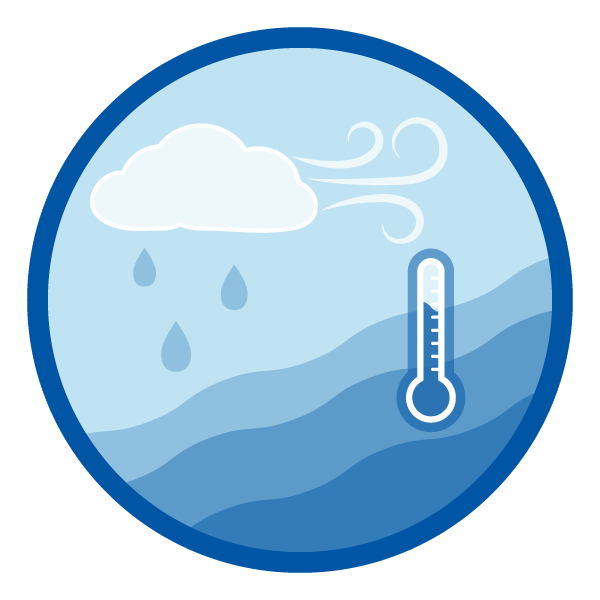 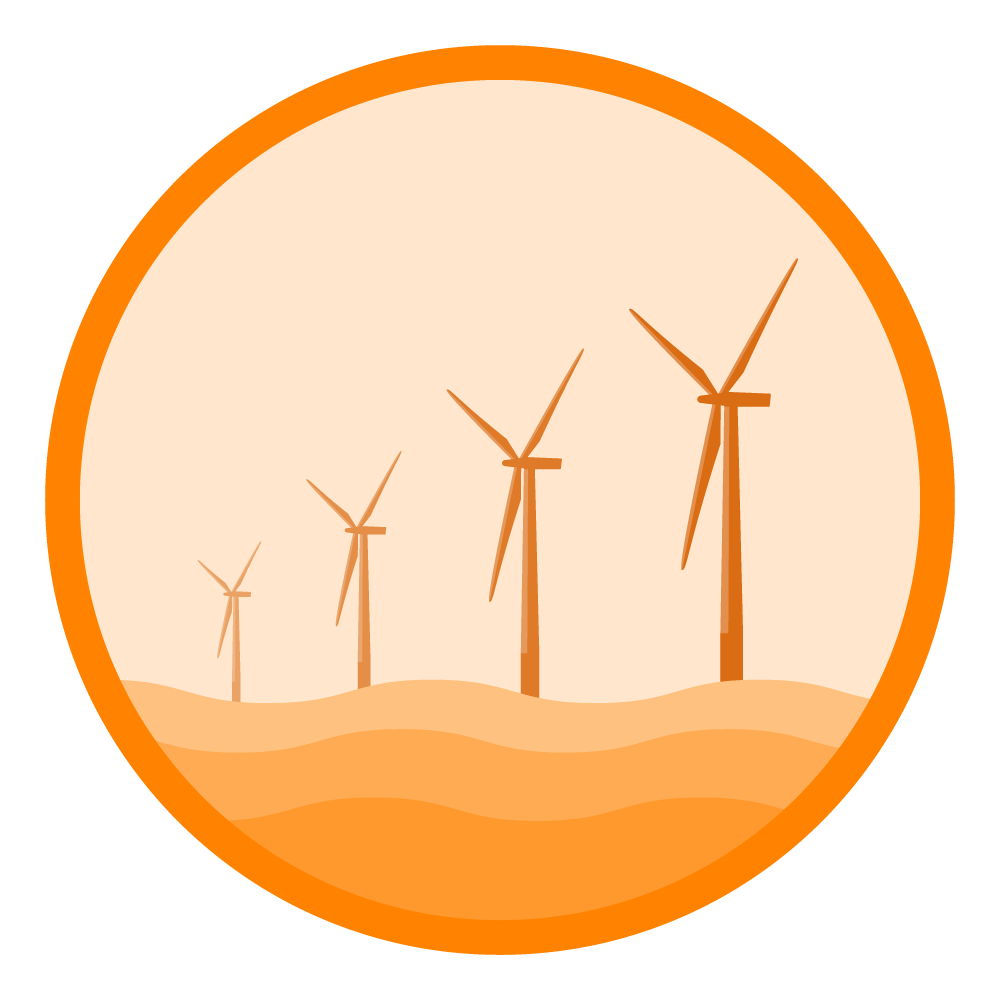 ] .center[ 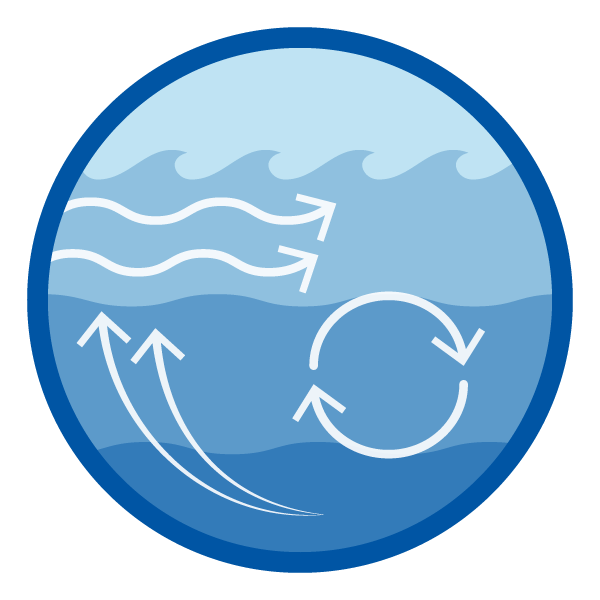  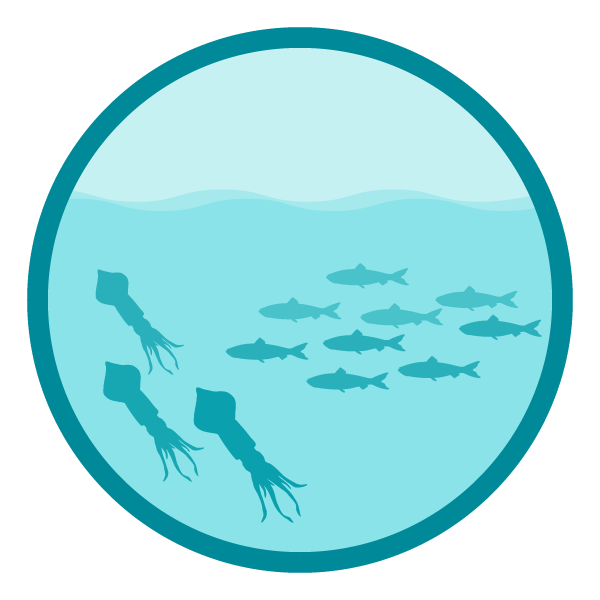 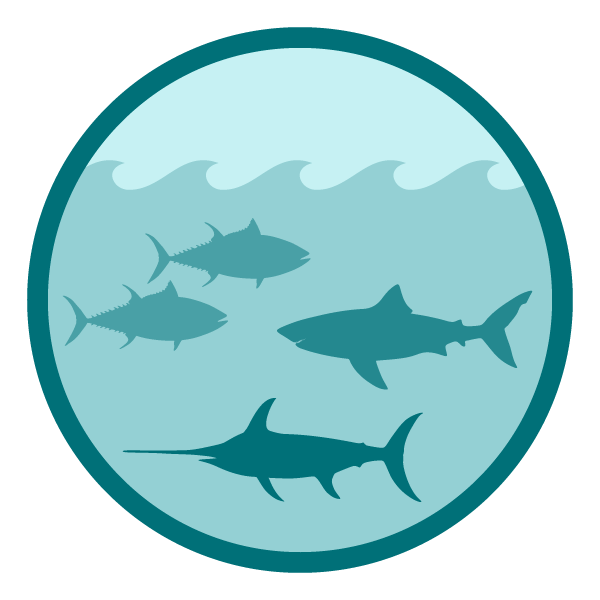 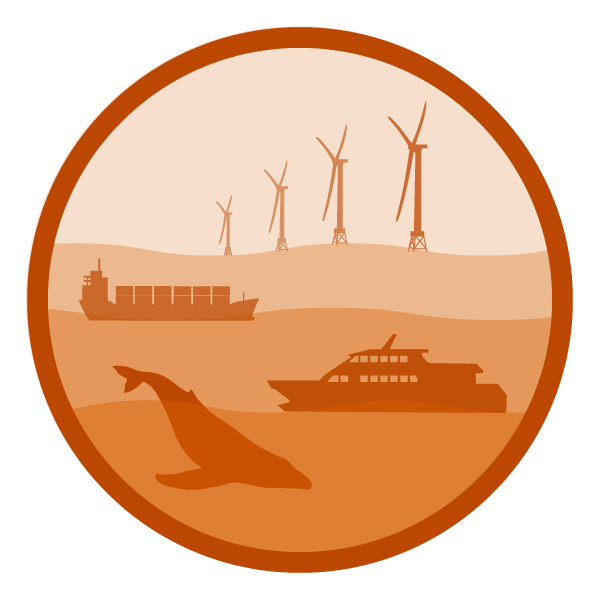 ] --- background-image: url("EDAB_images/seasonal-sst-anom-gridded-2021.png") background-size: 600px background-position: right top ## Risks: Climate change .pull-left[ Indicators: ocean currents, bottom and surface temperature, marine heatwaves <img src="20220427_UM_MEES631_Gaichas_files/figure-html/unnamed-chunk-15-1.png" width="288" style="display: block; margin: auto;" /> <img src="20220427_UM_MEES631_Gaichas_files/figure-html/unnamed-chunk-16-1.png" width="288" style="display: block; margin: auto;" /> <img src="20220427_UM_MEES631_Gaichas_files/figure-html/unnamed-chunk-17-1.png" width="504" style="display: block; margin: auto;" /> ] .pull-right[ <img src="20220427_UM_MEES631_Gaichas_files/figure-html/unnamed-chunk-18-1.png" width="360" style="display: block; margin: auto;" /> ] ??? A marine heatwave is a warming event that lasts for five or more days with sea surface temperatures above the 90th percentile of the historical daily climatology (1982-2011). --- ## Risks: Climate change and estuarine habitat   Risk element: EstHabitat 11 <span style="background-color:lightgreen;">low</span>, 4 <span style="background-color:red;">high</span> risk species .pull-left[ Indicators: Chesapeake Bay temperature and salinity <img src="20220427_UM_MEES631_Gaichas_files/figure-html/unnamed-chunk-19-1.png" width="504" style="display: block; margin: auto;" /> <!-- <img src="20220427_UM_MEES631_Gaichas_files/figure-html/unnamed-chunk-20-1.png" width="360" style="display: block; margin: auto;" /> <img src="20220427_UM_MEES631_Gaichas_files/figure-html/unnamed-chunk-21-1.png" width="360" style="display: block; margin: auto;" /> 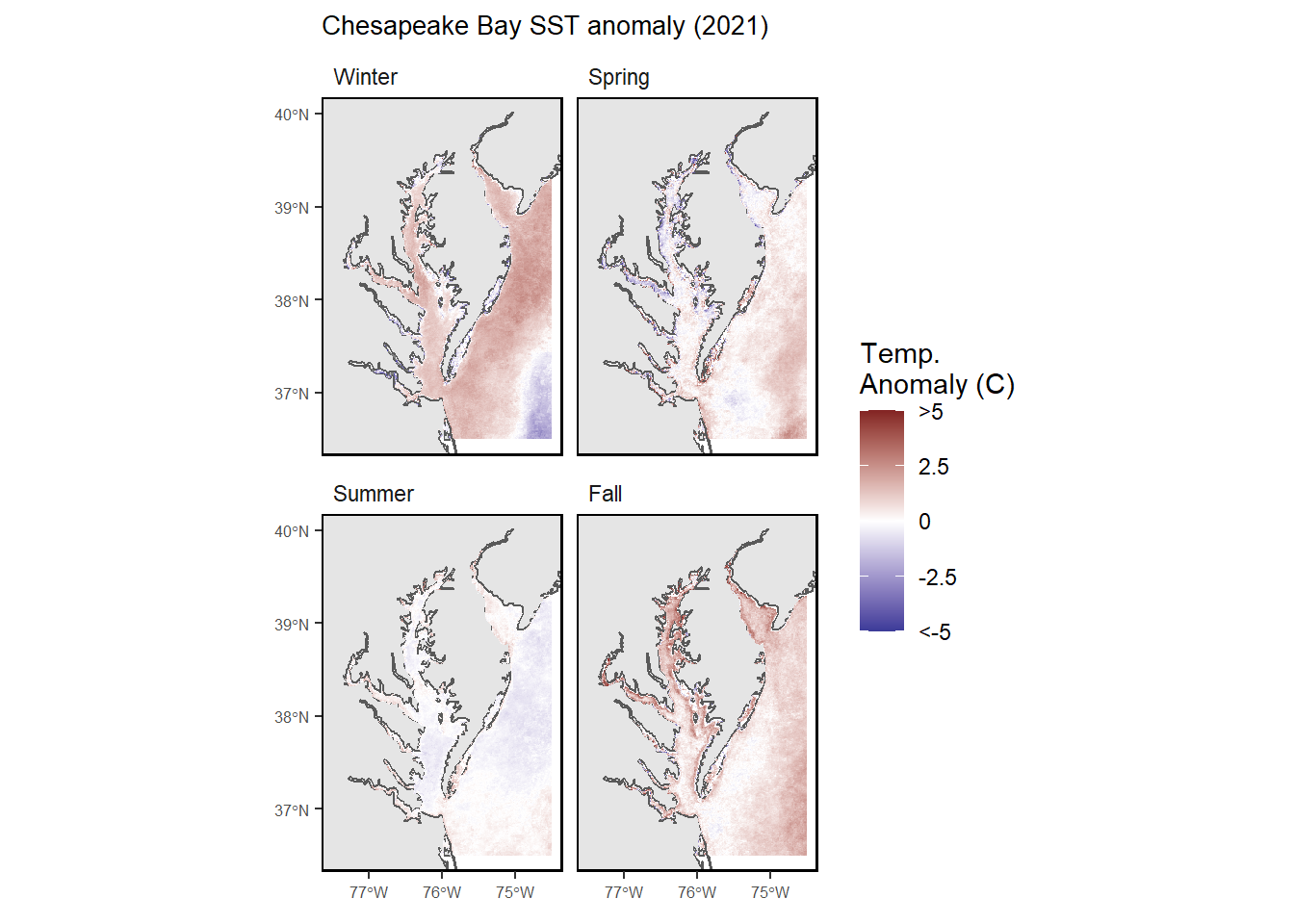--> ] .pull-right[ Indicator: SAV trends in Chesapeake Bay <img src="20220427_UM_MEES631_Gaichas_files/figure-html/unnamed-chunk-22-1.png" width="432" style="display: block; margin: auto;" /> Indicator: Water quality attainment <img src="20220427_UM_MEES631_Gaichas_files/figure-html/unnamed-chunk-23-1.png" width="432" style="display: block; margin: auto;" /> ] --- ## Risks: Climate change and offshore habitat   Risk element: offshore habitat put aside, new indices .pull-left[ Indicator: cold pool indices <img src="20220427_UM_MEES631_Gaichas_files/figure-html/unnamed-chunk-24-1.png" width="504" style="display: block; margin: auto;" /> Indicator: Ocean acidification 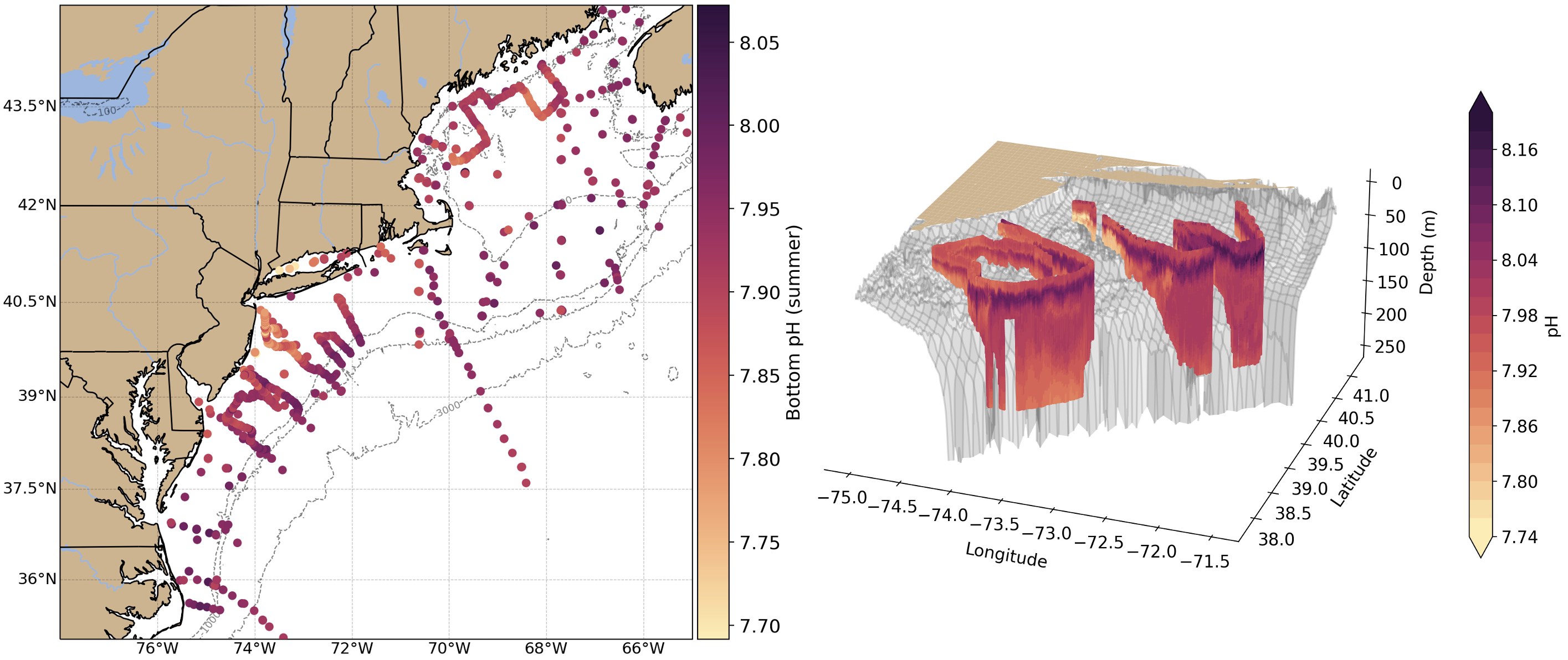 ] .pull-right[ Indicator: warm core rings <img src="20220427_UM_MEES631_Gaichas_files/figure-html/unnamed-chunk-25-1.png" width="504" style="display: block; margin: auto;" /> .center[  ] ] --- ## Risks: Ecosystem productivity   Risk element: <span style="background-color:yellow;">EcoProd</span>, unchanged, new indices Indicators: chlorophyll, primary production, zooplankton .pull-left[ <img src="20220427_UM_MEES631_Gaichas_files/figure-html/unnamed-chunk-26-1.png" width="504" style="display: block; margin: auto;" /> ] .pull-right[ <img src="20220427_UM_MEES631_Gaichas_files/figure-html/unnamed-chunk-27-1.png" width="504" style="display: block; margin: auto;" /> .reduced_opacity[ <img src="20220427_UM_MEES631_Gaichas_files/figure-html/unnamed-chunk-28-1.png" width="576" style="display: block; margin: auto;" /> ] ] Implications: increased production by smaller phytoplankton implies less efficient transfer of primary production to higher trophic levels. Monitor implications of increasing gelatinous zooplankton and krill. ??? Below average phytoplankton biomass could be due to reduced nutrient flow to the surface and/or increased grazing pressure. A short fall bloom was detected in November. Primary productivity (the rate of photosynthesis) was average to below average throughout 2021 --- ## Risks: Ecosystem productivity   Risk element: <span style="background-color:yellow;">EcoProd</span>, unchanged, new indices <img src="20220427_UM_MEES631_Gaichas_files/figure-html/unnamed-chunk-29-1.png" width="90%" style="display: block; margin: auto;" /> Implications: fluctuating environmental conditions and prey for forage species affect both abundance and energy content. Energy content varies by season, and has changed over time most dramatically for Atlantic herring --- ## Risks: Ecosystem productivity   Risk element: <span style="background-color:yellow;">EcoProd</span>, unchanged, new analyses .pull-left[ Indicator: fish condition <img src="20220427_UM_MEES631_Gaichas_files/figure-html/unnamed-chunk-30-1.png" width="120%" style="display: block; margin: auto;" /> <!--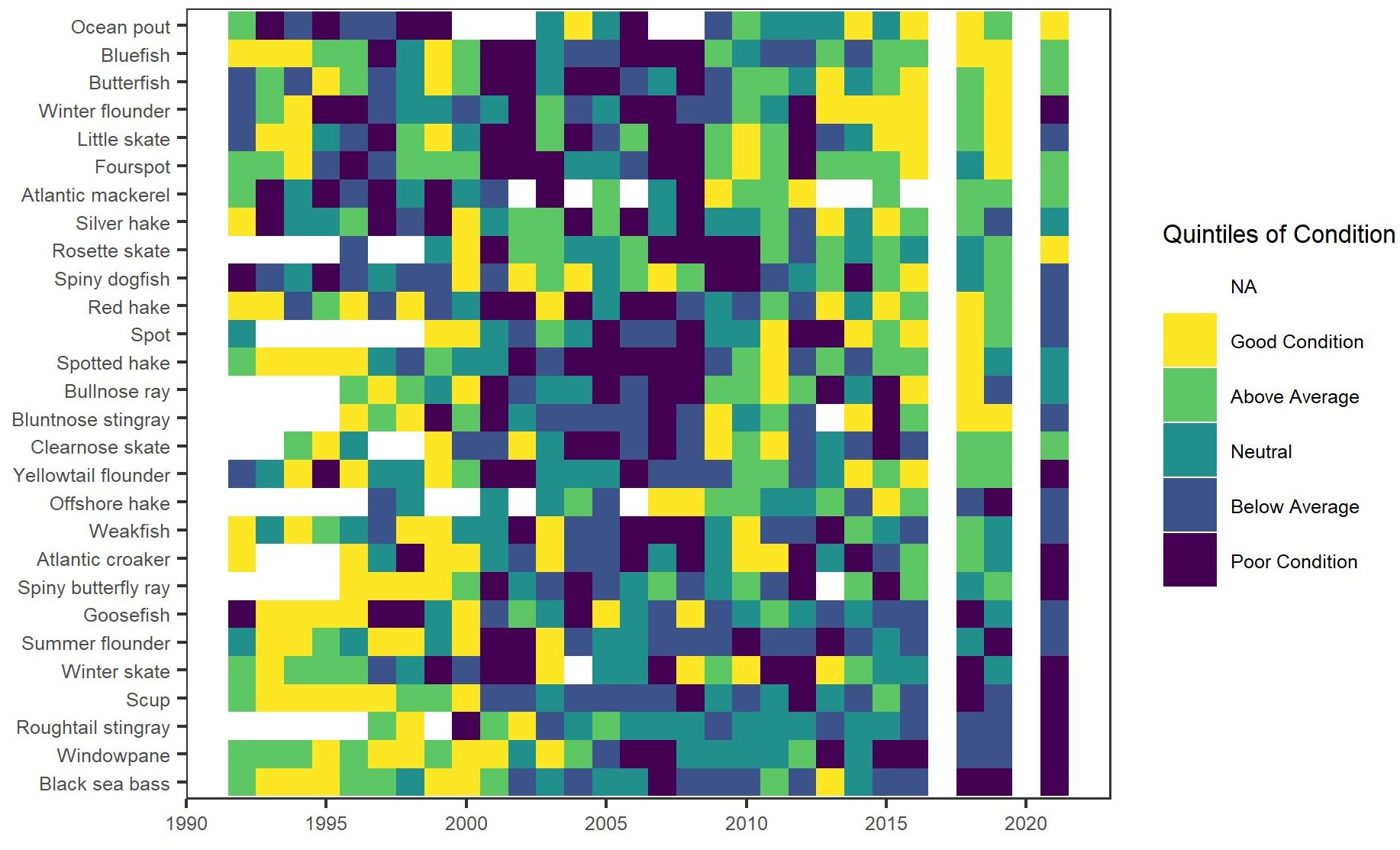--> ] .pull-right[ Indicator: fish productivity anomaly <img src="20220427_UM_MEES631_Gaichas_files/figure-html/unnamed-chunk-31-1.png" width="504" style="display: block; margin: auto;" /> ] Implications: Most species in the MAB had below average or poor condition again in 2021. Preliminary results of synthetic analyses show that changes in temperature, zooplankton, fishing pressure, and population size influence the condition of different fish species. ??? --- ## Risks: Ecosystem structure   add new risk assessment elements? Indicators: distribution shifts, diversity, predator status and trends .pull-left[ *No trend in aggregate sharks* <img src="20220427_UM_MEES631_Gaichas_files/figure-html/unnamed-chunk-32-1.png" width="504" style="display: block; margin: auto;" /> *HMS populations mainly at or above target* <img src="20220427_UM_MEES631_Gaichas_files/figure-html/unnamed-chunk-33-1.png" width="504" style="display: block; margin: auto;" /> ] .pull-right[ *Gray seals increasing (details in NE report)* * Breeding season ~ 27,000 US gray seals, Canada's population ~ 425,000 (2016) * Canada's population increasing at ~ 4% per year * U.S. pupping sites increased from 1 (1988) to 9 (2019) * Harbor and gray seals are generalist predators that consume more than 30 different prey species: red, white and silver hake, sand lance, yellowtail flounder, four-spotted flounder, Gulf-stream flounder, haddock, herring, redfish, and squids. Implications: stable predator populations suggest stable predation pressure on managed species, but increasing predator populations may reflect increasing predation pressure. ] ??? A survey conducted in 2021 in both countries will provide updated estimates of abundance. --- ## Implications: Climate change and managed species   Risk elements unchanged, new info: .pull-left[ Climate: 6 <span style="background-color:lightgreen;">low</span>, 3 <span style="background-color:yellow;">low-mod</span>, 4 <span style="background-color:orange;">mod-high</span>, 1 <span style="background-color:red;">high</span> risk *Multiple drivers with different impacts by species* * Seasonal estuarine conditions affect life stages of striped bass, blue crabs, summer flounder, black sea bass differently .contrib[ + Chesapeake summer hypoxia, temperature better than in past years, but worse in fall + Habitat improving in some areas (tidal fresh SAV, oyster reefs), but eelgrass declining ] * Ocean acidification impact on vulnerable surfclams .contrib[ + Areas of low pH identified in surfclam and scallop habitat + Lab work identified pH thresholds for surfclam growth ] * Warm core rings important to *Illex* availability. Fishing effort concentrates on the eastern edge of warm core rings, where upwelling and enhanced productivity ocurr ] .pull-right[ DistShift: 2 <span style="background-color:lightgreen;">low</span>, 9 <span style="background-color:orange;">mod-high</span>, 3 <span style="background-color:red;">high</span> risk species Shifting species distributions alter both species interactions, fishery interactions, and expected management outcomes from spatial allocations and bycatch measures based on historical fish and protected species distributions. .center[ 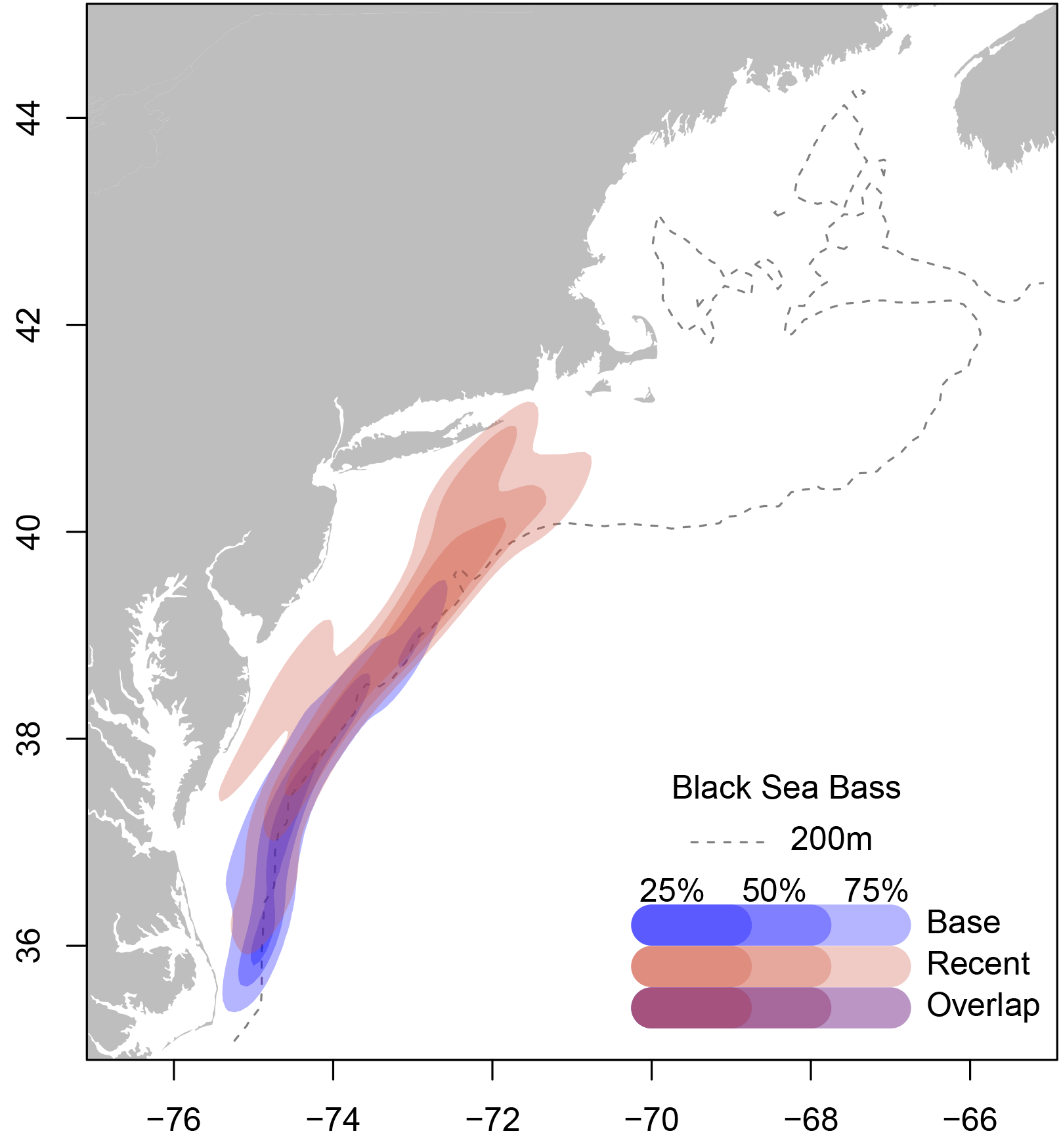 ] ] --- ## EAFM Risk Assessment: 2022 Update .pull-left[ *Species level risk elements* <table class="risktable table" style="font-size: 9px; margin-left: auto; margin-right: auto;"> <thead> <tr> <th style="text-align:left;"> Species </th> <th style="text-align:left;"> Assess </th> <th style="text-align:left;"> Fstatus </th> <th style="text-align:left;"> Bstatus </th> <th style="text-align:left;"> FW1Pred </th> <th style="text-align:left;"> FW1Prey </th> <th style="text-align:left;"> FW2Prey </th> <th style="text-align:left;"> Climate </th> <th style="text-align:left;"> DistShift </th> <th style="text-align:left;"> EstHabitat </th> </tr> </thead> <tbody> <tr> <td style="text-align:left;"> Ocean Quahog </td> <td style="text-align:left;"> <span style=" color: black !important;padding-right: 4px; padding-left: 4px; background-color: lightgreen !important;text-align: c;">lowest</span> </td> <td style="text-align:left;"> <span style=" color: black !important;padding-right: 4px; padding-left: 4px; background-color: lightgreen !important;text-align: c;">lowest</span> </td> <td style="text-align:left;"> <span style=" color: black !important;padding-right: 4px; padding-left: 4px; background-color: lightgreen !important;text-align: c;">lowest</span> </td> <td style="text-align:left;"> <span style=" color: black !important;padding-right: 4px; padding-left: 4px; background-color: lightgreen !important;text-align: c;">lowest</span> </td> <td style="text-align:left;"> <span style=" color: black !important;padding-right: 4px; padding-left: 4px; background-color: lightgreen !important;text-align: c;">lowest</span> </td> <td style="text-align:left;"> <span style=" color: black !important;padding-right: 4px; padding-left: 4px; background-color: lightgreen !important;text-align: c;">lowest</span> </td> <td style="text-align:left;"> <span style=" color: white !important;padding-right: 4px; padding-left: 4px; background-color: red !important;text-align: c;">highest</span> </td> <td style="text-align:left;"> <span style=" color: black !important;padding-right: 4px; padding-left: 4px; background-color: orange !important;text-align: c;">modhigh</span> </td> <td style="text-align:left;"> <span style=" color: black !important;padding-right: 4px; padding-left: 4px; background-color: lightgreen !important;text-align: c;">lowest</span> </td> </tr> <tr> <td style="text-align:left;"> Surfclam </td> <td style="text-align:left;"> <span style=" color: black !important;padding-right: 4px; padding-left: 4px; background-color: lightgreen !important;text-align: c;">lowest</span> </td> <td style="text-align:left;"> <span style=" color: black !important;padding-right: 4px; padding-left: 4px; background-color: lightgreen !important;text-align: c;">lowest</span> </td> <td style="text-align:left;"> <span style=" color: black !important;padding-right: 4px; padding-left: 4px; background-color: lightgreen !important;text-align: c;">lowest</span> </td> <td style="text-align:left;"> <span style=" color: black !important;padding-right: 4px; padding-left: 4px; background-color: lightgreen !important;text-align: c;">lowest</span> </td> <td style="text-align:left;"> <span style=" color: black !important;padding-right: 4px; padding-left: 4px; background-color: lightgreen !important;text-align: c;">lowest</span> </td> <td style="text-align:left;"> <span style=" color: black !important;padding-right: 4px; padding-left: 4px; background-color: lightgreen !important;text-align: c;">lowest</span> </td> <td style="text-align:left;"> <span style=" color: black !important;padding-right: 4px; padding-left: 4px; background-color: orange !important;text-align: c;">modhigh</span> </td> <td style="text-align:left;"> <span style=" color: black !important;padding-right: 4px; padding-left: 4px; background-color: orange !important;text-align: c;">modhigh</span> </td> <td style="text-align:left;"> <span style=" color: black !important;padding-right: 4px; padding-left: 4px; background-color: lightgreen !important;text-align: c;">lowest</span> </td> </tr> <tr> <td style="text-align:left;"> Summer flounder </td> <td style="text-align:left;"> <span style=" color: black !important;padding-right: 4px; padding-left: 4px; background-color: lightgreen !important;text-align: c;">lowest</span> </td> <td style="text-align:left;"> <span style=" color: black !important;padding-right: 4px; padding-left: 4px; background-color: lightgreen !important;text-align: c;">lowest</span> </td> <td style="text-align:left;"> <span style=" color: black !important;padding-right: 4px; padding-left: 4px; background-color: yellow !important;text-align: c;">lowmod</span> </td> <td style="text-align:left;"> <span style=" color: black !important;padding-right: 4px; padding-left: 4px; background-color: lightgreen !important;text-align: c;">lowest</span> </td> <td style="text-align:left;"> <span style=" color: black !important;padding-right: 4px; padding-left: 4px; background-color: lightgreen !important;text-align: c;">lowest</span> </td> <td style="text-align:left;"> <span style=" color: black !important;padding-right: 4px; padding-left: 4px; background-color: lightgreen !important;text-align: c;">lowest</span> </td> <td style="text-align:left;"> <span style=" color: black !important;padding-right: 4px; padding-left: 4px; background-color: yellow !important;text-align: c;">lowmod</span> </td> <td style="text-align:left;"> <span style=" color: black !important;padding-right: 4px; padding-left: 4px; background-color: orange !important;text-align: c;">modhigh</span> </td> <td style="text-align:left;"> <span style=" color: white !important;padding-right: 4px; padding-left: 4px; background-color: red !important;text-align: c;">highest</span> </td> </tr> <tr> <td style="text-align:left;"> Scup </td> <td style="text-align:left;"> <span style=" color: black !important;padding-right: 4px; padding-left: 4px; background-color: lightgreen !important;text-align: c;">lowest</span> </td> <td style="text-align:left;"> <span style=" color: black !important;padding-right: 4px; padding-left: 4px; background-color: lightgreen !important;text-align: c;">lowest</span> </td> <td style="text-align:left;"> <span style=" color: black !important;padding-right: 4px; padding-left: 4px; background-color: lightgreen !important;text-align: c;">lowest</span> </td> <td style="text-align:left;"> <span style=" color: black !important;padding-right: 4px; padding-left: 4px; background-color: lightgreen !important;text-align: c;">lowest</span> </td> <td style="text-align:left;"> <span style=" color: black !important;padding-right: 4px; padding-left: 4px; background-color: lightgreen !important;text-align: c;">lowest</span> </td> <td style="text-align:left;"> <span style=" color: black !important;padding-right: 4px; padding-left: 4px; background-color: lightgreen !important;text-align: c;">lowest</span> </td> <td style="text-align:left;"> <span style=" color: black !important;padding-right: 4px; padding-left: 4px; background-color: yellow !important;text-align: c;">lowmod</span> </td> <td style="text-align:left;"> <span style=" color: black !important;padding-right: 4px; padding-left: 4px; background-color: orange !important;text-align: c;">modhigh</span> </td> <td style="text-align:left;"> <span style=" color: white !important;padding-right: 4px; padding-left: 4px; background-color: red !important;text-align: c;">highest</span> </td> </tr> <tr> <td style="text-align:left;"> Black sea bass </td> <td style="text-align:left;"> <span style=" color: black !important;padding-right: 4px; padding-left: 4px; background-color: lightgreen !important;text-align: c;">lowest</span> </td> <td style="text-align:left;"> <span style=" color: black !important;padding-right: 4px; padding-left: 4px; background-color: lightgreen !important;text-align: c;">lowest</span> </td> <td style="text-align:left;"> <span style=" color: black !important;padding-right: 4px; padding-left: 4px; background-color: lightgreen !important;text-align: c;">lowest</span> </td> <td style="text-align:left;"> <span style=" color: black !important;padding-right: 4px; padding-left: 4px; background-color: lightgreen !important;text-align: c;">lowest</span> </td> <td style="text-align:left;"> <span style=" color: black !important;padding-right: 4px; padding-left: 4px; background-color: lightgreen !important;text-align: c;">lowest</span> </td> <td style="text-align:left;"> <span style=" color: black !important;padding-right: 4px; padding-left: 4px; background-color: lightgreen !important;text-align: c;">lowest</span> </td> <td style="text-align:left;"> <span style=" color: black !important;padding-right: 4px; padding-left: 4px; background-color: orange !important;text-align: c;">modhigh</span> </td> <td style="text-align:left;"> <span style=" color: black !important;padding-right: 4px; padding-left: 4px; background-color: orange !important;text-align: c;">modhigh</span> </td> <td style="text-align:left;"> <span style=" color: white !important;padding-right: 4px; padding-left: 4px; background-color: red !important;text-align: c;">highest</span> </td> </tr> <tr> <td style="text-align:left;"> Atl. mackerel </td> <td style="text-align:left;"> <span style=" color: black !important;padding-right: 4px; padding-left: 4px; background-color: lightgreen !important;text-align: c;">lowest</span> </td> <td style="text-align:left;"> <span style=" color: white !important;padding-right: 4px; padding-left: 4px; background-color: red !important;text-align: c;">highest</span> </td> <td style="text-align:left;"> <span style=" color: white !important;padding-right: 4px; padding-left: 4px; background-color: red !important;text-align: c;">highest</span> </td> <td style="text-align:left;"> <span style=" color: black !important;padding-right: 4px; padding-left: 4px; background-color: lightgreen !important;text-align: c;">lowest</span> </td> <td style="text-align:left;"> <span style=" color: black !important;padding-right: 4px; padding-left: 4px; background-color: lightgreen !important;text-align: c;">lowest</span> </td> <td style="text-align:left;"> <span style=" color: black !important;padding-right: 4px; padding-left: 4px; background-color: lightgreen !important;text-align: c;">lowest</span> </td> <td style="text-align:left;"> <span style=" color: black !important;padding-right: 4px; padding-left: 4px; background-color: yellow !important;text-align: c;">lowmod</span> </td> <td style="text-align:left;"> <span style=" color: black !important;padding-right: 4px; padding-left: 4px; background-color: orange !important;text-align: c;">modhigh</span> </td> <td style="text-align:left;"> <span style=" color: black !important;padding-right: 4px; padding-left: 4px; background-color: lightgreen !important;text-align: c;">lowest</span> </td> </tr> <tr> <td style="text-align:left;"> Chub mackerel </td> <td style="text-align:left;"> <span style=" color: white !important;padding-right: 4px; padding-left: 4px; background-color: red !important;text-align: c;">highest</span> </td> <td style="text-align:left;"> <span style=" color: black !important;padding-right: 4px; padding-left: 4px; background-color: yellow !important;text-align: c;">lowmod</span> </td> <td style="text-align:left;"> <span style=" color: black !important;padding-right: 4px; padding-left: 4px; background-color: yellow !important;text-align: c;">lowmod</span> </td> <td style="text-align:left;"> <span style=" color: black !important;padding-right: 4px; padding-left: 4px; background-color: lightgreen !important;text-align: c;">lowest</span> </td> <td style="text-align:left;"> <span style=" color: black !important;padding-right: 4px; padding-left: 4px; background-color: lightgreen !important;text-align: c;">lowest</span> </td> <td style="text-align:left;"> <span style=" color: black !important;padding-right: 4px; padding-left: 4px; background-color: lightgreen !important;text-align: c;">lowest</span> </td> <td style="text-align:left;"> <span style=" color: black !important;padding-right: 4px; padding-left: 4px; background-color: white !important;text-align: c;">na</span> </td> <td style="text-align:left;"> <span style=" color: black !important;padding-right: 4px; padding-left: 4px; background-color: white !important;text-align: c;">na</span> </td> <td style="text-align:left;"> <span style=" color: black !important;padding-right: 4px; padding-left: 4px; background-color: lightgreen !important;text-align: c;">lowest</span> </td> </tr> <tr> <td style="text-align:left;"> Butterfish </td> <td style="text-align:left;"> <span style=" color: black !important;padding-right: 4px; padding-left: 4px; background-color: lightgreen !important;text-align: c;">lowest</span> </td> <td style="text-align:left;"> <span style=" color: black !important;padding-right: 4px; padding-left: 4px; background-color: lightgreen !important;text-align: c;">lowest</span> </td> <td style="text-align:left;"> <span style=" color: black !important;padding-right: 4px; padding-left: 4px; background-color: yellow !important;text-align: c;">lowmod</span> </td> <td style="text-align:left;"> <span style=" color: black !important;padding-right: 4px; padding-left: 4px; background-color: lightgreen !important;text-align: c;">lowest</span> </td> <td style="text-align:left;"> <span style=" color: black !important;padding-right: 4px; padding-left: 4px; background-color: lightgreen !important;text-align: c;">lowest</span> </td> <td style="text-align:left;"> <span style=" color: black !important;padding-right: 4px; padding-left: 4px; background-color: lightgreen !important;text-align: c;">lowest</span> </td> <td style="text-align:left;"> <span style=" color: black !important;padding-right: 4px; padding-left: 4px; background-color: lightgreen !important;text-align: c;">lowest</span> </td> <td style="text-align:left;"> <span style=" color: white !important;padding-right: 4px; padding-left: 4px; background-color: red !important;text-align: c;">highest</span> </td> <td style="text-align:left;"> <span style=" color: black !important;padding-right: 4px; padding-left: 4px; background-color: lightgreen !important;text-align: c;">lowest</span> </td> </tr> <tr> <td style="text-align:left;"> Longfin squid </td> <td style="text-align:left;"> <span style=" color: black !important;padding-right: 4px; padding-left: 4px; background-color: yellow !important;text-align: c;">lowmod</span> </td> <td style="text-align:left;"> <span style=" color: black !important;padding-right: 4px; padding-left: 4px; background-color: yellow !important;text-align: c;">lowmod</span> </td> <td style="text-align:left;"> <span style=" color: black !important;padding-right: 4px; padding-left: 4px; background-color: yellow !important;text-align: c;">lowmod</span> </td> <td style="text-align:left;"> <span style=" color: black !important;padding-right: 4px; padding-left: 4px; background-color: lightgreen !important;text-align: c;">lowest</span> </td> <td style="text-align:left;"> <span style=" color: black !important;padding-right: 4px; padding-left: 4px; background-color: lightgreen !important;text-align: c;">lowest</span> </td> <td style="text-align:left;"> <span style=" color: black !important;padding-right: 4px; padding-left: 4px; background-color: yellow !important;text-align: c;">lowmod</span> </td> <td style="text-align:left;"> <span style=" color: black !important;padding-right: 4px; padding-left: 4px; background-color: lightgreen !important;text-align: c;">lowest</span> </td> <td style="text-align:left;"> <span style=" color: black !important;padding-right: 4px; padding-left: 4px; background-color: orange !important;text-align: c;">modhigh</span> </td> <td style="text-align:left;"> <span style=" color: black !important;padding-right: 4px; padding-left: 4px; background-color: lightgreen !important;text-align: c;">lowest</span> </td> </tr> <tr> <td style="text-align:left;"> Shortfin squid </td> <td style="text-align:left;"> <span style=" color: black !important;padding-right: 4px; padding-left: 4px; background-color: yellow !important;text-align: c;">lowmod</span> </td> <td style="text-align:left;"> <span style=" color: black !important;padding-right: 4px; padding-left: 4px; background-color: yellow !important;text-align: c;">lowmod</span> </td> <td style="text-align:left;"> <span style=" color: black !important;padding-right: 4px; padding-left: 4px; background-color: yellow !important;text-align: c;">lowmod</span> </td> <td style="text-align:left;"> <span style=" color: black !important;padding-right: 4px; padding-left: 4px; background-color: lightgreen !important;text-align: c;">lowest</span> </td> <td style="text-align:left;"> <span style=" color: black !important;padding-right: 4px; padding-left: 4px; background-color: lightgreen !important;text-align: c;">lowest</span> </td> <td style="text-align:left;"> <span style=" color: black !important;padding-right: 4px; padding-left: 4px; background-color: yellow !important;text-align: c;">lowmod</span> </td> <td style="text-align:left;"> <span style=" color: black !important;padding-right: 4px; padding-left: 4px; background-color: lightgreen !important;text-align: c;">lowest</span> </td> <td style="text-align:left;"> <span style=" color: white !important;padding-right: 4px; padding-left: 4px; background-color: red !important;text-align: c;">highest</span> </td> <td style="text-align:left;"> <span style=" color: black !important;padding-right: 4px; padding-left: 4px; background-color: lightgreen !important;text-align: c;">lowest</span> </td> </tr> <tr> <td style="text-align:left;"> Golden tilefish </td> <td style="text-align:left;"> <span style=" color: black !important;padding-right: 4px; padding-left: 4px; background-color: lightgreen !important;text-align: c;">lowest</span> </td> <td style="text-align:left;"> <span style=" color: black !important;padding-right: 4px; padding-left: 4px; background-color: lightgreen !important;text-align: c;">lowest</span> </td> <td style="text-align:left;"> <span style=" color: black !important;padding-right: 4px; padding-left: 4px; background-color: yellow !important;text-align: c;">lowmod</span> </td> <td style="text-align:left;"> <span style=" color: black !important;padding-right: 4px; padding-left: 4px; background-color: lightgreen !important;text-align: c;">lowest</span> </td> <td style="text-align:left;"> <span style=" color: black !important;padding-right: 4px; padding-left: 4px; background-color: lightgreen !important;text-align: c;">lowest</span> </td> <td style="text-align:left;"> <span style=" color: black !important;padding-right: 4px; padding-left: 4px; background-color: lightgreen !important;text-align: c;">lowest</span> </td> <td style="text-align:left;"> <span style=" color: black !important;padding-right: 4px; padding-left: 4px; background-color: orange !important;text-align: c;">modhigh</span> </td> <td style="text-align:left;"> <span style=" color: black !important;padding-right: 4px; padding-left: 4px; background-color: lightgreen !important;text-align: c;">lowest</span> </td> <td style="text-align:left;"> <span style=" color: black !important;padding-right: 4px; padding-left: 4px; background-color: lightgreen !important;text-align: c;">lowest</span> </td> </tr> <tr> <td style="text-align:left;"> Blueline tilefish </td> <td style="text-align:left;"> <span style=" color: white !important;padding-right: 4px; padding-left: 4px; background-color: red !important;text-align: c;">highest</span> </td> <td style="text-align:left;"> <span style=" color: white !important;padding-right: 4px; padding-left: 4px; background-color: red !important;text-align: c;">highest</span> </td> <td style="text-align:left;"> <span style=" color: black !important;padding-right: 4px; padding-left: 4px; background-color: orange !important;text-align: c;">modhigh</span> </td> <td style="text-align:left;"> <span style=" color: black !important;padding-right: 4px; padding-left: 4px; background-color: lightgreen !important;text-align: c;">lowest</span> </td> <td style="text-align:left;"> <span style=" color: black !important;padding-right: 4px; padding-left: 4px; background-color: lightgreen !important;text-align: c;">lowest</span> </td> <td style="text-align:left;"> <span style=" color: black !important;padding-right: 4px; padding-left: 4px; background-color: lightgreen !important;text-align: c;">lowest</span> </td> <td style="text-align:left;"> <span style=" color: black !important;padding-right: 4px; padding-left: 4px; background-color: orange !important;text-align: c;">modhigh</span> </td> <td style="text-align:left;"> <span style=" color: black !important;padding-right: 4px; padding-left: 4px; background-color: lightgreen !important;text-align: c;">lowest</span> </td> <td style="text-align:left;"> <span style=" color: black !important;padding-right: 4px; padding-left: 4px; background-color: lightgreen !important;text-align: c;">lowest</span> </td> </tr> <tr> <td style="text-align:left;"> Bluefish </td> <td style="text-align:left;"> <span style=" color: black !important;padding-right: 4px; padding-left: 4px; background-color: lightgreen !important;text-align: c;">lowest</span> </td> <td style="text-align:left;"> <span style=" color: black !important;padding-right: 4px; padding-left: 4px; background-color: lightgreen !important;text-align: c;">lowest</span> </td> <td style="text-align:left;"> <span style=" color: white !important;padding-right: 4px; padding-left: 4px; background-color: red !important;text-align: c;">highest</span> </td> <td style="text-align:left;"> <span style=" color: black !important;padding-right: 4px; padding-left: 4px; background-color: lightgreen !important;text-align: c;">lowest</span> </td> <td style="text-align:left;"> <span style=" color: black !important;padding-right: 4px; padding-left: 4px; background-color: lightgreen !important;text-align: c;">lowest</span> </td> <td style="text-align:left;"> <span style=" color: black !important;padding-right: 4px; padding-left: 4px; background-color: lightgreen !important;text-align: c;">lowest</span> </td> <td style="text-align:left;"> <span style=" color: black !important;padding-right: 4px; padding-left: 4px; background-color: lightgreen !important;text-align: c;">lowest</span> </td> <td style="text-align:left;"> <span style=" color: black !important;padding-right: 4px; padding-left: 4px; background-color: orange !important;text-align: c;">modhigh</span> </td> <td style="text-align:left;"> <span style=" color: white !important;padding-right: 4px; padding-left: 4px; background-color: red !important;text-align: c;">highest</span> </td> </tr> <tr> <td style="text-align:left;"> Spiny dogfish </td> <td style="text-align:left;"> <span style=" color: black !important;padding-right: 4px; padding-left: 4px; background-color: yellow !important;text-align: c;">lowmod</span> </td> <td style="text-align:left;"> <span style=" color: black !important;padding-right: 4px; padding-left: 4px; background-color: lightgreen !important;text-align: c;">lowest</span> </td> <td style="text-align:left;"> <span style=" color: black !important;padding-right: 4px; padding-left: 4px; background-color: yellow !important;text-align: c;">lowmod</span> </td> <td style="text-align:left;"> <span style=" color: black !important;padding-right: 4px; padding-left: 4px; background-color: lightgreen !important;text-align: c;">lowest</span> </td> <td style="text-align:left;"> <span style=" color: black !important;padding-right: 4px; padding-left: 4px; background-color: lightgreen !important;text-align: c;">lowest</span> </td> <td style="text-align:left;"> <span style=" color: black !important;padding-right: 4px; padding-left: 4px; background-color: lightgreen !important;text-align: c;">lowest</span> </td> <td style="text-align:left;"> <span style=" color: black !important;padding-right: 4px; padding-left: 4px; background-color: lightgreen !important;text-align: c;">lowest</span> </td> <td style="text-align:left;"> <span style=" color: white !important;padding-right: 4px; padding-left: 4px; background-color: red !important;text-align: c;">highest</span> </td> <td style="text-align:left;"> <span style=" color: black !important;padding-right: 4px; padding-left: 4px; background-color: lightgreen !important;text-align: c;">lowest</span> </td> </tr> <tr> <td style="text-align:left;"> Monkfish </td> <td style="text-align:left;"> <span style=" color: white !important;padding-right: 4px; padding-left: 4px; background-color: red !important;text-align: c;">highest</span> </td> <td style="text-align:left;"> <span style=" color: black !important;padding-right: 4px; padding-left: 4px; background-color: yellow !important;text-align: c;">lowmod</span> </td> <td style="text-align:left;"> <span style=" color: black !important;padding-right: 4px; padding-left: 4px; background-color: yellow !important;text-align: c;">lowmod</span> </td> <td style="text-align:left;"> <span style=" color: black !important;padding-right: 4px; padding-left: 4px; background-color: lightgreen !important;text-align: c;">lowest</span> </td> <td style="text-align:left;"> <span style=" color: black !important;padding-right: 4px; padding-left: 4px; background-color: lightgreen !important;text-align: c;">lowest</span> </td> <td style="text-align:left;"> <span style=" color: black !important;padding-right: 4px; padding-left: 4px; background-color: lightgreen !important;text-align: c;">lowest</span> </td> <td style="text-align:left;"> <span style=" color: black !important;padding-right: 4px; padding-left: 4px; background-color: lightgreen !important;text-align: c;">lowest</span> </td> <td style="text-align:left;"> <span style=" color: black !important;padding-right: 4px; padding-left: 4px; background-color: orange !important;text-align: c;">modhigh</span> </td> <td style="text-align:left;"> <span style=" color: black !important;padding-right: 4px; padding-left: 4px; background-color: lightgreen !important;text-align: c;">lowest</span> </td> </tr> <tr> <td style="text-align:left;"> Unmanaged forage </td> <td style="text-align:left;"> <span style=" color: black !important;padding-right: 4px; padding-left: 4px; background-color: white !important;text-align: c;">na</span> </td> <td style="text-align:left;"> <span style=" color: black !important;padding-right: 4px; padding-left: 4px; background-color: white !important;text-align: c;">na</span> </td> <td style="text-align:left;"> <span style=" color: black !important;padding-right: 4px; padding-left: 4px; background-color: white !important;text-align: c;">na</span> </td> <td style="text-align:left;"> <span style=" color: black !important;padding-right: 4px; padding-left: 4px; background-color: lightgreen !important;text-align: c;">lowest</span> </td> <td style="text-align:left;"> <span style=" color: black !important;padding-right: 4px; padding-left: 4px; background-color: yellow !important;text-align: c;">lowmod</span> </td> <td style="text-align:left;"> <span style=" color: black !important;padding-right: 4px; padding-left: 4px; background-color: yellow !important;text-align: c;">lowmod</span> </td> <td style="text-align:left;"> <span style=" color: black !important;padding-right: 4px; padding-left: 4px; background-color: white !important;text-align: c;">na</span> </td> <td style="text-align:left;"> <span style=" color: black !important;padding-right: 4px; padding-left: 4px; background-color: white !important;text-align: c;">na</span> </td> <td style="text-align:left;"> <span style=" color: black !important;padding-right: 4px; padding-left: 4px; background-color: white !important;text-align: c;">na</span> </td> </tr> <tr> <td style="text-align:left;"> Deepsea corals </td> <td style="text-align:left;"> <span style=" color: black !important;padding-right: 4px; padding-left: 4px; background-color: white !important;text-align: c;">na</span> </td> <td style="text-align:left;"> <span style=" color: black !important;padding-right: 4px; padding-left: 4px; background-color: white !important;text-align: c;">na</span> </td> <td style="text-align:left;"> <span style=" color: black !important;padding-right: 4px; padding-left: 4px; background-color: white !important;text-align: c;">na</span> </td> <td style="text-align:left;"> <span style=" color: black !important;padding-right: 4px; padding-left: 4px; background-color: lightgreen !important;text-align: c;">lowest</span> </td> <td style="text-align:left;"> <span style=" color: black !important;padding-right: 4px; padding-left: 4px; background-color: lightgreen !important;text-align: c;">lowest</span> </td> <td style="text-align:left;"> <span style=" color: black !important;padding-right: 4px; padding-left: 4px; background-color: lightgreen !important;text-align: c;">lowest</span> </td> <td style="text-align:left;"> <span style=" color: black !important;padding-right: 4px; padding-left: 4px; background-color: white !important;text-align: c;">na</span> </td> <td style="text-align:left;"> <span style=" color: black !important;padding-right: 4px; padding-left: 4px; background-color: white !important;text-align: c;">na</span> </td> <td style="text-align:left;"> <span style=" color: black !important;padding-right: 4px; padding-left: 4px; background-color: white !important;text-align: c;">na</span> </td> </tr> </tbody> </table> .contrib[ * Chub mackerel were added to the table ] *Ecosystem level risk elements* <table class="risktable table" style="font-size: 9px; margin-left: auto; margin-right: auto;"> <thead> <tr> <th style="text-align:left;"> System </th> <th style="text-align:left;"> EcoProd </th> <th style="text-align:left;"> CommRev </th> <th style="text-align:left;"> RecVal </th> <th style="text-align:left;"> FishRes1 </th> <th style="text-align:left;"> FishRes4 </th> <th style="text-align:left;"> FleetDiv </th> <th style="text-align:left;"> Social </th> <th style="text-align:left;"> ComFood </th> <th style="text-align:left;"> RecFood </th> </tr> </thead> <tbody> <tr> <td style="text-align:left;"> Mid-Atlantic </td> <td style="text-align:left;"> <span style=" color: black !important;padding-right: 4px; padding-left: 4px; background-color: yellow !important;text-align: c;">lowmod</span> </td> <td style="text-align:left;"> <span style=" color: black !important;padding-right: 4px; padding-left: 4px; background-color: orange !important;text-align: c;">modhigh</span> </td> <td style="text-align:left;"> <span style=" color: black !important;padding-right: 4px; padding-left: 4px; background-color: yellow !important;text-align: c;">lowmod</span> </td> <td style="text-align:left;"> <span style=" color: black !important;padding-right: 4px; padding-left: 4px; background-color: lightgreen !important;text-align: c;">lowest</span> </td> <td style="text-align:left;"> <span style=" color: black !important;padding-right: 4px; padding-left: 4px; background-color: orange !important;text-align: c;">modhigh</span> </td> <td style="text-align:left;"> <span style=" color: black !important;padding-right: 4px; padding-left: 4px; background-color: lightgreen !important;text-align: c;">lowest</span> </td> <td style="text-align:left;"> <span style=" color: black !important;padding-right: 4px; padding-left: 4px; background-color: yellow !important;text-align: c;">lowmod</span> </td> <td style="text-align:left;"> <span style=" color: white !important;padding-right: 4px; padding-left: 4px; background-color: red !important;text-align: c;">highest</span> </td> <td style="text-align:left;"> <span style=" color: black !important;padding-right: 4px; padding-left: 4px; background-color: orange !important;text-align: c;">modhigh</span> </td> </tr> </tbody> </table> .contrib[ * Recreational value risk decreased from high to low-moderate ] ] .pull-right[ *Species and Sector level risk elements* <table class="risktable table" style="font-size: 11px; margin-left: auto; margin-right: auto;"> <thead> <tr> <th style="text-align:left;"> Species </th> <th style="text-align:left;"> MgtControl </th> <th style="text-align:left;"> TecInteract </th> <th style="text-align:left;"> OceanUse </th> <th style="text-align:left;"> RegComplex </th> <th style="text-align:left;"> Discards </th> <th style="text-align:left;"> Allocation </th> </tr> </thead> <tbody> <tr> <td style="text-align:left;"> Ocean Quahog-C </td> <td style="text-align:left;"> <span style=" color: black !important;padding-right: 4px; padding-left: 4px; background-color: lightgreen !important;text-align: c;">lowest</span> </td> <td style="text-align:left;"> <span style=" color: black !important;padding-right: 4px; padding-left: 4px; background-color: lightgreen !important;text-align: c;">lowest</span> </td> <td style="text-align:left;"> <span style=" color: black !important;padding-right: 4px; padding-left: 4px; background-color: yellow !important;text-align: c;">lowmod</span> </td> <td style="text-align:left;"> <span style=" color: black !important;padding-right: 4px; padding-left: 4px; background-color: lightgreen !important;text-align: c;">lowest</span> </td> <td style="text-align:left;"> <span style=" color: black !important;padding-right: 4px; padding-left: 4px; background-color: orange !important;text-align: c;">modhigh</span> </td> <td style="text-align:left;"> <span style=" color: black !important;padding-right: 4px; padding-left: 4px; background-color: lightgreen !important;text-align: c;">lowest</span> </td> </tr> <tr> <td style="text-align:left;"> Surfclam-C </td> <td style="text-align:left;"> <span style=" color: black !important;padding-right: 4px; padding-left: 4px; background-color: lightgreen !important;text-align: c;">lowest</span> </td> <td style="text-align:left;"> <span style=" color: black !important;padding-right: 4px; padding-left: 4px; background-color: lightgreen !important;text-align: c;">lowest</span> </td> <td style="text-align:left;"> <span style=" color: black !important;padding-right: 4px; padding-left: 4px; background-color: yellow !important;text-align: c;">lowmod</span> </td> <td style="text-align:left;"> <span style=" color: black !important;padding-right: 4px; padding-left: 4px; background-color: lightgreen !important;text-align: c;">lowest</span> </td> <td style="text-align:left;"> <span style=" color: black !important;padding-right: 4px; padding-left: 4px; background-color: orange !important;text-align: c;">modhigh</span> </td> <td style="text-align:left;"> <span style=" color: black !important;padding-right: 4px; padding-left: 4px; background-color: lightgreen !important;text-align: c;">lowest</span> </td> </tr> <tr> <td style="text-align:left;"> Summer flounder-R </td> <td style="text-align:left;"> <span style=" color: black !important;padding-right: 4px; padding-left: 4px; background-color: orange !important;text-align: c;">modhigh</span> </td> <td style="text-align:left;"> <span style=" color: black !important;padding-right: 4px; padding-left: 4px; background-color: lightgreen !important;text-align: c;">lowest</span> </td> <td style="text-align:left;"> <span style=" color: black !important;padding-right: 4px; padding-left: 4px; background-color: yellow !important;text-align: c;">lowmod</span> </td> <td style="text-align:left;"> <span style=" color: black !important;padding-right: 4px; padding-left: 4px; background-color: orange !important;text-align: c;">modhigh</span> </td> <td style="text-align:left;"> <span style=" color: white !important;padding-right: 4px; padding-left: 4px; background-color: red !important;text-align: c;">highest</span> </td> <td style="text-align:left;"> <span style=" color: white !important;padding-right: 4px; padding-left: 4px; background-color: red !important;text-align: c;">highest</span> </td> </tr> <tr> <td style="text-align:left;"> Summer flounder-C </td> <td style="text-align:left;"> <span style=" color: black !important;padding-right: 4px; padding-left: 4px; background-color: yellow !important;text-align: c;">lowmod</span> </td> <td style="text-align:left;"> <span style=" color: black !important;padding-right: 4px; padding-left: 4px; background-color: orange !important;text-align: c;">modhigh</span> </td> <td style="text-align:left;"> <span style=" color: black !important;padding-right: 4px; padding-left: 4px; background-color: yellow !important;text-align: c;">lowmod</span> </td> <td style="text-align:left;"> <span style=" color: black !important;padding-right: 4px; padding-left: 4px; background-color: orange !important;text-align: c;">modhigh</span> </td> <td style="text-align:left;"> <span style=" color: black !important;padding-right: 4px; padding-left: 4px; background-color: orange !important;text-align: c;">modhigh</span> </td> <td style="text-align:left;"> <span style=" color: black !important;padding-right: 4px; padding-left: 4px; background-color: lightgreen !important;text-align: c;">lowest</span> </td> </tr> <tr> <td style="text-align:left;"> Scup-R </td> <td style="text-align:left;"> <span style=" color: black !important;padding-right: 4px; padding-left: 4px; background-color: yellow !important;text-align: c;">lowmod</span> </td> <td style="text-align:left;"> <span style=" color: black !important;padding-right: 4px; padding-left: 4px; background-color: lightgreen !important;text-align: c;">lowest</span> </td> <td style="text-align:left;"> <span style=" color: black !important;padding-right: 4px; padding-left: 4px; background-color: yellow !important;text-align: c;">lowmod</span> </td> <td style="text-align:left;"> <span style=" color: black !important;padding-right: 4px; padding-left: 4px; background-color: orange !important;text-align: c;">modhigh</span> </td> <td style="text-align:left;"> <span style=" color: black !important;padding-right: 4px; padding-left: 4px; background-color: orange !important;text-align: c;">modhigh</span> </td> <td style="text-align:left;"> <span style=" color: white !important;padding-right: 4px; padding-left: 4px; background-color: red !important;text-align: c;">highest</span> </td> </tr> <tr> <td style="text-align:left;"> Scup-C </td> <td style="text-align:left;"> <span style=" color: black !important;padding-right: 4px; padding-left: 4px; background-color: lightgreen !important;text-align: c;">lowest</span> </td> <td style="text-align:left;"> <span style=" color: black !important;padding-right: 4px; padding-left: 4px; background-color: yellow !important;text-align: c;">lowmod</span> </td> <td style="text-align:left;"> <span style=" color: black !important;padding-right: 4px; padding-left: 4px; background-color: orange !important;text-align: c;">modhigh</span> </td> <td style="text-align:left;"> <span style=" color: black !important;padding-right: 4px; padding-left: 4px; background-color: orange !important;text-align: c;">modhigh</span> </td> <td style="text-align:left;"> <span style=" color: black !important;padding-right: 4px; padding-left: 4px; background-color: orange !important;text-align: c;">modhigh</span> </td> <td style="text-align:left;"> <span style=" color: black !important;padding-right: 4px; padding-left: 4px; background-color: lightgreen !important;text-align: c;">lowest</span> </td> </tr> <tr> <td style="text-align:left;"> Black sea bass-R </td> <td style="text-align:left;"> <span style=" color: white !important;padding-right: 4px; padding-left: 4px; background-color: red !important;text-align: c;">highest</span> </td> <td style="text-align:left;"> <span style=" color: black !important;padding-right: 4px; padding-left: 4px; background-color: lightgreen !important;text-align: c;">lowest</span> </td> <td style="text-align:left;"> <span style=" color: black !important;padding-right: 4px; padding-left: 4px; background-color: orange !important;text-align: c;">modhigh</span> </td> <td style="text-align:left;"> <span style=" color: black !important;padding-right: 4px; padding-left: 4px; background-color: orange !important;text-align: c;">modhigh</span> </td> <td style="text-align:left;"> <span style=" color: white !important;padding-right: 4px; padding-left: 4px; background-color: red !important;text-align: c;">highest</span> </td> <td style="text-align:left;"> <span style=" color: white !important;padding-right: 4px; padding-left: 4px; background-color: red !important;text-align: c;">highest</span> </td> </tr> <tr> <td style="text-align:left;"> Black sea bass-C </td> <td style="text-align:left;"> <span style=" color: white !important;padding-right: 4px; padding-left: 4px; background-color: red !important;text-align: c;">highest</span> </td> <td style="text-align:left;"> <span style=" color: black !important;padding-right: 4px; padding-left: 4px; background-color: yellow !important;text-align: c;">lowmod</span> </td> <td style="text-align:left;"> <span style=" color: white !important;padding-right: 4px; padding-left: 4px; background-color: red !important;text-align: c;">highest</span> </td> <td style="text-align:left;"> <span style=" color: black !important;padding-right: 4px; padding-left: 4px; background-color: orange !important;text-align: c;">modhigh</span> </td> <td style="text-align:left;"> <span style=" color: white !important;padding-right: 4px; padding-left: 4px; background-color: red !important;text-align: c;">highest</span> </td> <td style="text-align:left;"> <span style=" color: black !important;padding-right: 4px; padding-left: 4px; background-color: lightgreen !important;text-align: c;">lowest</span> </td> </tr> <tr> <td style="text-align:left;"> Atl. mackerel-R </td> <td style="text-align:left;"> <span style=" color: black !important;padding-right: 4px; padding-left: 4px; background-color: yellow !important;text-align: c;">lowmod</span> </td> <td style="text-align:left;"> <span style=" color: black !important;padding-right: 4px; padding-left: 4px; background-color: lightgreen !important;text-align: c;">lowest</span> </td> <td style="text-align:left;"> <span style=" color: black !important;padding-right: 4px; padding-left: 4px; background-color: lightgreen !important;text-align: c;">lowest</span> </td> <td style="text-align:left;"> <span style=" color: black !important;padding-right: 4px; padding-left: 4px; background-color: yellow !important;text-align: c;">lowmod</span> </td> <td style="text-align:left;"> <span style=" color: black !important;padding-right: 4px; padding-left: 4px; background-color: lightgreen !important;text-align: c;">lowest</span> </td> <td style="text-align:left;"> <span style=" color: black !important;padding-right: 4px; padding-left: 4px; background-color: lightgreen !important;text-align: c;">lowest</span> </td> </tr> <tr> <td style="text-align:left;"> Atl. mackerel-C </td> <td style="text-align:left;"> <span style=" color: black !important;padding-right: 4px; padding-left: 4px; background-color: lightgreen !important;text-align: c;">lowest</span> </td> <td style="text-align:left;"> <span style=" color: black !important;padding-right: 4px; padding-left: 4px; background-color: yellow !important;text-align: c;">lowmod</span> </td> <td style="text-align:left;"> <span style=" color: black !important;padding-right: 4px; padding-left: 4px; background-color: orange !important;text-align: c;">modhigh</span> </td> <td style="text-align:left;"> <span style=" color: white !important;padding-right: 4px; padding-left: 4px; background-color: red !important;text-align: c;">highest</span> </td> <td style="text-align:left;"> <span style=" color: black !important;padding-right: 4px; padding-left: 4px; background-color: yellow !important;text-align: c;">lowmod</span> </td> <td style="text-align:left;"> <span style=" color: white !important;padding-right: 4px; padding-left: 4px; background-color: red !important;text-align: c;">highest</span> </td> </tr> <tr> <td style="text-align:left;"> Butterfish-C </td> <td style="text-align:left;"> <span style=" color: black !important;padding-right: 4px; padding-left: 4px; background-color: lightgreen !important;text-align: c;">lowest</span> </td> <td style="text-align:left;"> <span style=" color: black !important;padding-right: 4px; padding-left: 4px; background-color: yellow !important;text-align: c;">lowmod</span> </td> <td style="text-align:left;"> <span style=" color: black !important;padding-right: 4px; padding-left: 4px; background-color: orange !important;text-align: c;">modhigh</span> </td> <td style="text-align:left;"> <span style=" color: black !important;padding-right: 4px; padding-left: 4px; background-color: orange !important;text-align: c;">modhigh</span> </td> <td style="text-align:left;"> <span style=" color: black !important;padding-right: 4px; padding-left: 4px; background-color: orange !important;text-align: c;">modhigh</span> </td> <td style="text-align:left;"> <span style=" color: black !important;padding-right: 4px; padding-left: 4px; background-color: lightgreen !important;text-align: c;">lowest</span> </td> </tr> <tr> <td style="text-align:left;"> Longfin squid-C </td> <td style="text-align:left;"> <span style=" color: black !important;padding-right: 4px; padding-left: 4px; background-color: lightgreen !important;text-align: c;">lowest</span> </td> <td style="text-align:left;"> <span style=" color: black !important;padding-right: 4px; padding-left: 4px; background-color: orange !important;text-align: c;">modhigh</span> </td> <td style="text-align:left;"> <span style=" color: white !important;padding-right: 4px; padding-left: 4px; background-color: red !important;text-align: c;">highest</span> </td> <td style="text-align:left;"> <span style=" color: black !important;padding-right: 4px; padding-left: 4px; background-color: orange !important;text-align: c;">modhigh</span> </td> <td style="text-align:left;"> <span style=" color: white !important;padding-right: 4px; padding-left: 4px; background-color: red !important;text-align: c;">highest</span> </td> <td style="text-align:left;"> <span style=" color: black !important;padding-right: 4px; padding-left: 4px; background-color: lightgreen !important;text-align: c;">lowest</span> </td> </tr> <tr> <td style="text-align:left;"> Shortfin squid-C </td> <td style="text-align:left;"> <span style=" color: black !important;padding-right: 4px; padding-left: 4px; background-color: yellow !important;text-align: c;">lowmod</span> </td> <td style="text-align:left;"> <span style=" color: black !important;padding-right: 4px; padding-left: 4px; background-color: yellow !important;text-align: c;">lowmod</span> </td> <td style="text-align:left;"> <span style=" color: black !important;padding-right: 4px; padding-left: 4px; background-color: yellow !important;text-align: c;">lowmod</span> </td> <td style="text-align:left;"> <span style=" color: black !important;padding-right: 4px; padding-left: 4px; background-color: orange !important;text-align: c;">modhigh</span> </td> <td style="text-align:left;"> <span style=" color: black !important;padding-right: 4px; padding-left: 4px; background-color: lightgreen !important;text-align: c;">lowest</span> </td> <td style="text-align:left;"> <span style=" color: white !important;padding-right: 4px; padding-left: 4px; background-color: red !important;text-align: c;">highest</span> </td> </tr> <tr> <td style="text-align:left;"> Golden tilefish-R </td> <td style="text-align:left;"> <span style=" color: black !important;padding-right: 4px; padding-left: 4px; background-color: white !important;text-align: c;">na</span> </td> <td style="text-align:left;"> <span style=" color: black !important;padding-right: 4px; padding-left: 4px; background-color: lightgreen !important;text-align: c;">lowest</span> </td> <td style="text-align:left;"> <span style=" color: black !important;padding-right: 4px; padding-left: 4px; background-color: lightgreen !important;text-align: c;">lowest</span> </td> <td style="text-align:left;"> <span style=" color: black !important;padding-right: 4px; padding-left: 4px; background-color: lightgreen !important;text-align: c;">lowest</span> </td> <td style="text-align:left;"> <span style=" color: black !important;padding-right: 4px; padding-left: 4px; background-color: lightgreen !important;text-align: c;">lowest</span> </td> <td style="text-align:left;"> <span style=" color: black !important;padding-right: 4px; padding-left: 4px; background-color: lightgreen !important;text-align: c;">lowest</span> </td> </tr> <tr> <td style="text-align:left;"> Golden tilefish-C </td> <td style="text-align:left;"> <span style=" color: black !important;padding-right: 4px; padding-left: 4px; background-color: lightgreen !important;text-align: c;">lowest</span> </td> <td style="text-align:left;"> <span style=" color: black !important;padding-right: 4px; padding-left: 4px; background-color: lightgreen !important;text-align: c;">lowest</span> </td> <td style="text-align:left;"> <span style=" color: black !important;padding-right: 4px; padding-left: 4px; background-color: lightgreen !important;text-align: c;">lowest</span> </td> <td style="text-align:left;"> <span style=" color: black !important;padding-right: 4px; padding-left: 4px; background-color: lightgreen !important;text-align: c;">lowest</span> </td> <td style="text-align:left;"> <span style=" color: black !important;padding-right: 4px; padding-left: 4px; background-color: lightgreen !important;text-align: c;">lowest</span> </td> <td style="text-align:left;"> <span style=" color: black !important;padding-right: 4px; padding-left: 4px; background-color: lightgreen !important;text-align: c;">lowest</span> </td> </tr> <tr> <td style="text-align:left;"> Blueline tilefish-R </td> <td style="text-align:left;"> <span style=" color: black !important;padding-right: 4px; padding-left: 4px; background-color: yellow !important;text-align: c;">lowmod</span> </td> <td style="text-align:left;"> <span style=" color: black !important;padding-right: 4px; padding-left: 4px; background-color: lightgreen !important;text-align: c;">lowest</span> </td> <td style="text-align:left;"> <span style=" color: black !important;padding-right: 4px; padding-left: 4px; background-color: lightgreen !important;text-align: c;">lowest</span> </td> <td style="text-align:left;"> <span style=" color: black !important;padding-right: 4px; padding-left: 4px; background-color: yellow !important;text-align: c;">lowmod</span> </td> <td style="text-align:left;"> <span style=" color: black !important;padding-right: 4px; padding-left: 4px; background-color: lightgreen !important;text-align: c;">lowest</span> </td> <td style="text-align:left;"> <span style=" color: black !important;padding-right: 4px; padding-left: 4px; background-color: lightgreen !important;text-align: c;">lowest</span> </td> </tr> <tr> <td style="text-align:left;"> Blueline tilefish-C </td> <td style="text-align:left;"> <span style=" color: black !important;padding-right: 4px; padding-left: 4px; background-color: yellow !important;text-align: c;">lowmod</span> </td> <td style="text-align:left;"> <span style=" color: black !important;padding-right: 4px; padding-left: 4px; background-color: lightgreen !important;text-align: c;">lowest</span> </td> <td style="text-align:left;"> <span style=" color: black !important;padding-right: 4px; padding-left: 4px; background-color: lightgreen !important;text-align: c;">lowest</span> </td> <td style="text-align:left;"> <span style=" color: black !important;padding-right: 4px; padding-left: 4px; background-color: yellow !important;text-align: c;">lowmod</span> </td> <td style="text-align:left;"> <span style=" color: black !important;padding-right: 4px; padding-left: 4px; background-color: lightgreen !important;text-align: c;">lowest</span> </td> <td style="text-align:left;"> <span style=" color: black !important;padding-right: 4px; padding-left: 4px; background-color: lightgreen !important;text-align: c;">lowest</span> </td> </tr> <tr> <td style="text-align:left;"> Bluefish-R </td> <td style="text-align:left;"> <span style=" color: black !important;padding-right: 4px; padding-left: 4px; background-color: yellow !important;text-align: c;">lowmod</span> </td> <td style="text-align:left;"> <span style=" color: black !important;padding-right: 4px; padding-left: 4px; background-color: lightgreen !important;text-align: c;">lowest</span> </td> <td style="text-align:left;"> <span style=" color: black !important;padding-right: 4px; padding-left: 4px; background-color: lightgreen !important;text-align: c;">lowest</span> </td> <td style="text-align:left;"> <span style=" color: black !important;padding-right: 4px; padding-left: 4px; background-color: yellow !important;text-align: c;">lowmod</span> </td> <td style="text-align:left;"> <span style=" color: black !important;padding-right: 4px; padding-left: 4px; background-color: orange !important;text-align: c;">modhigh</span> </td> <td style="text-align:left;"> <span style=" color: white !important;padding-right: 4px; padding-left: 4px; background-color: red !important;text-align: c;">highest</span> </td> </tr> <tr> <td style="text-align:left;"> Bluefish-C </td> <td style="text-align:left;"> <span style=" color: black !important;padding-right: 4px; padding-left: 4px; background-color: lightgreen !important;text-align: c;">lowest</span> </td> <td style="text-align:left;"> <span style=" color: black !important;padding-right: 4px; padding-left: 4px; background-color: lightgreen !important;text-align: c;">lowest</span> </td> <td style="text-align:left;"> <span style=" color: black !important;padding-right: 4px; padding-left: 4px; background-color: yellow !important;text-align: c;">lowmod</span> </td> <td style="text-align:left;"> <span style=" color: black !important;padding-right: 4px; padding-left: 4px; background-color: yellow !important;text-align: c;">lowmod</span> </td> <td style="text-align:left;"> <span style=" color: black !important;padding-right: 4px; padding-left: 4px; background-color: yellow !important;text-align: c;">lowmod</span> </td> <td style="text-align:left;"> <span style=" color: black !important;padding-right: 4px; padding-left: 4px; background-color: lightgreen !important;text-align: c;">lowest</span> </td> </tr> <tr> <td style="text-align:left;"> Spiny dogfish-R </td> <td style="text-align:left;"> <span style=" color: black !important;padding-right: 4px; padding-left: 4px; background-color: lightgreen !important;text-align: c;">lowest</span> </td> <td style="text-align:left;"> <span style=" color: black !important;padding-right: 4px; padding-left: 4px; background-color: lightgreen !important;text-align: c;">lowest</span> </td> <td style="text-align:left;"> <span style=" color: black !important;padding-right: 4px; padding-left: 4px; background-color: lightgreen !important;text-align: c;">lowest</span> </td> <td style="text-align:left;"> <span style=" color: black !important;padding-right: 4px; padding-left: 4px; background-color: lightgreen !important;text-align: c;">lowest</span> </td> <td style="text-align:left;"> <span style=" color: black !important;padding-right: 4px; padding-left: 4px; background-color: lightgreen !important;text-align: c;">lowest</span> </td> <td style="text-align:left;"> <span style=" color: black !important;padding-right: 4px; padding-left: 4px; background-color: lightgreen !important;text-align: c;">lowest</span> </td> </tr> <tr> <td style="text-align:left;"> Spiny dogfish-C </td> <td style="text-align:left;"> <span style=" color: black !important;padding-right: 4px; padding-left: 4px; background-color: lightgreen !important;text-align: c;">lowest</span> </td> <td style="text-align:left;"> <span style=" color: black !important;padding-right: 4px; padding-left: 4px; background-color: orange !important;text-align: c;">modhigh</span> </td> <td style="text-align:left;"> <span style=" color: black !important;padding-right: 4px; padding-left: 4px; background-color: orange !important;text-align: c;">modhigh</span> </td> <td style="text-align:left;"> <span style=" color: black !important;padding-right: 4px; padding-left: 4px; background-color: orange !important;text-align: c;">modhigh</span> </td> <td style="text-align:left;"> <span style=" color: black !important;padding-right: 4px; padding-left: 4px; background-color: yellow !important;text-align: c;">lowmod</span> </td> <td style="text-align:left;"> <span style=" color: black !important;padding-right: 4px; padding-left: 4px; background-color: lightgreen !important;text-align: c;">lowest</span> </td> </tr> <tr> <td style="text-align:left;"> Chub mackerel-C </td> <td style="text-align:left;"> <span style=" color: black !important;padding-right: 4px; padding-left: 4px; background-color: lightgreen !important;text-align: c;">lowest</span> </td> <td style="text-align:left;"> <span style=" color: black !important;padding-right: 4px; padding-left: 4px; background-color: yellow !important;text-align: c;">lowmod</span> </td> <td style="text-align:left;"> <span style=" color: black !important;padding-right: 4px; padding-left: 4px; background-color: yellow !important;text-align: c;">lowmod</span> </td> <td style="text-align:left;"> <span style=" color: black !important;padding-right: 4px; padding-left: 4px; background-color: yellow !important;text-align: c;">lowmod</span> </td> <td style="text-align:left;"> <span style=" color: black !important;padding-right: 4px; padding-left: 4px; background-color: lightgreen !important;text-align: c;">lowest</span> </td> <td style="text-align:left;"> <span style=" color: black !important;padding-right: 4px; padding-left: 4px; background-color: lightgreen !important;text-align: c;">lowest</span> </td> </tr> <tr> <td style="text-align:left;"> Unmanaged forage </td> <td style="text-align:left;"> <span style=" color: black !important;padding-right: 4px; padding-left: 4px; background-color: lightgreen !important;text-align: c;">lowest</span> </td> <td style="text-align:left;"> <span style=" color: black !important;padding-right: 4px; padding-left: 4px; background-color: lightgreen !important;text-align: c;">lowest</span> </td> <td style="text-align:left;"> <span style=" color: black !important;padding-right: 4px; padding-left: 4px; background-color: orange !important;text-align: c;">modhigh</span> </td> <td style="text-align:left;"> <span style=" color: black !important;padding-right: 4px; padding-left: 4px; background-color: lightgreen !important;text-align: c;">lowest</span> </td> <td style="text-align:left;"> <span style=" color: black !important;padding-right: 4px; padding-left: 4px; background-color: lightgreen !important;text-align: c;">lowest</span> </td> <td style="text-align:left;"> <span style=" color: black !important;padding-right: 4px; padding-left: 4px; background-color: lightgreen !important;text-align: c;">lowest</span> </td> </tr> <tr> <td style="text-align:left;"> Deepsea corals </td> <td style="text-align:left;"> <span style=" color: black !important;padding-right: 4px; padding-left: 4px; background-color: white !important;text-align: c;">na</span> </td> <td style="text-align:left;"> <span style=" color: black !important;padding-right: 4px; padding-left: 4px; background-color: white !important;text-align: c;">na</span> </td> <td style="text-align:left;"> <span style=" color: black !important;padding-right: 4px; padding-left: 4px; background-color: orange !important;text-align: c;">modhigh</span> </td> <td style="text-align:left;"> <span style=" color: black !important;padding-right: 4px; padding-left: 4px; background-color: white !important;text-align: c;">na</span> </td> <td style="text-align:left;"> <span style=" color: black !important;padding-right: 4px; padding-left: 4px; background-color: white !important;text-align: c;">na</span> </td> <td style="text-align:left;"> <span style=" color: black !important;padding-right: 4px; padding-left: 4px; background-color: white !important;text-align: c;">na</span> </td> </tr> </tbody> </table> .contrib[ * 4 Allocation risks decreased from high to low * 4 Regulatory complexity risks decreased, 2 increased * Management control risk increased for blueline tilefish fisheries to low-moderate ] ] ??? Changes: Recreational value decreased from high to low-mod Allocation risk decreased for 4 fisheries from high to low (intermediate rankings not applied) Black sea bass regulatory complexity risk decreased from highest to moderate-high Potential new indicators from new SOE sections on climate risk, habitat vulnerability, offshore wind Habitat vulnerability analysis writeups--comments? --- background-image: url("EDAB_images/noaa-iea.png") background-size: 300px background-position: right bottom ## THANK YOU! SOEs made possible by (at least) 61 contributors from 14 institutions .pull-left[ .contrib[ Kimberly Bastille<br> Aaron Beaver (Anchor QEA)<br> Andy Beet<br> Ruth Boettcher (Virginia Department of Game and Inland Fisheries)<br> Mandy Bromilow (NOAA Chesapeake Bay Office)<br> Zhuomin Chen (Woods Hole Oceanographic Institution)<br> Joseph Caracappa<br> Doug Christel (GARFO)<br> Patricia Clay<br> Lisa Colburn<br> Jennifer Cudney (NMFS Atlantic HMS Management Division)<br> Tobey Curtis (NMFS Atlantic HMS Management Division)<br> Geret DePiper<br> Dan Dorfman (NOAA-NOS-NCCOS)<br> Hubert du Pontavice<br> Emily Farr (NMFS Office of Habitat Conservation)<br> Michael Fogarty<br> Paula Fratantoni<br> Kevin Friedland<br> Marjy Friedrichs (VIMS)<br> Sarah Gaichas<br> Ben Galuardi (GARFO)<br> Avijit Gangopadhyay (School for Marine Science and Technology, University of Massachusetts Dartmouth)<br> James Gartland (Virginia Institute of Marine Science)<br> Glen Gawarkiewicz (Woods Hole Oceanographic Institution)<br> Sean Hardison<br> Kimberly Hyde<br> John Kosik<br> Steve Kress (National Audubon Society’s Seabird Restoration Program)<br> Young-Oh Kwon (Woods Hole Oceanographic Institution)<br> ] ] .pull-right[ .contrib[ Scott Large<br> Andrew Lipsky<br> Sean Lucey<br> Don Lyons (National Audubon Society’s Seabird Restoration Program)<br> Chris Melrose<br> Shannon Meseck<br> Ryan Morse<br> Brandon Muffley (MAFMC)<br> Kimberly Murray<br> Chris Orphanides<br> Richard Pace<br> Tom Parham (Maryland DNR)<br> Charles Perretti<br> CJ Pellerin (NOAA Chesapeake Bay Office)<br> Grace Roskar (NMFS Office of Habitat Conservation)<br> Grace Saba (Rutgers)<br> Vincent Saba<br> Sarah Salois<br> Chris Schillaci (GARFO)<br> Dave Secor (CBL)<br> Angela Silva<br> Adrienne Silver (UMass/SMAST)<br> Emily Slesinger (Rutgers University)<br> Laurel Smith<br> Talya tenBrink (GARFO)<br> Bruce Vogt (NOAA Chesapeake Bay Office)<br> Ron Vogel (UMD Cooperative Institute for Satellite Earth System Studies and NOAA/NESDIS Center for Satellite Applications and Research)<br> John Walden<br> Harvey Walsh<br> Changhua Weng<br> Mark Wuenschel ] ] --- ## References .contrib[ <a name=bib-bastille_improving_2021></a>[Bastille, K. et al.](#cite-bastille_improving_2021) (2021). "Improving the IEA Approach Using Principles of Open Data Science". In: _Coastal Management_ 49.1. Publisher: Taylor & Francis \_ eprint: https://doi.org/10.1080/08920753.2021.1846155, pp. 72-89. ISSN: 0892-0753. DOI: [10.1080/08920753.2021.1846155](https://doi.org/10.1080%2F08920753.2021.1846155). URL: [https://doi.org/10.1080/08920753.2021.1846155](https://doi.org/10.1080/08920753.2021.1846155) (visited on Apr. 16, 2021). <a name=bib-depiper_operationalizing_2017></a>[DePiper, G. S. et al.](#cite-depiper_operationalizing_2017) (2017). "Operationalizing integrated ecosystem assessments within a multidisciplinary team: lessons learned from a worked example". En. In: _ICES Journal of Marine Science_ 74.8, pp. 2076-2086. ISSN: 1054-3139. DOI: [10.1093/icesjms/fsx038](https://doi.org/10.1093%2Ficesjms%2Ffsx038). URL: [https://academic.oup.com/icesjms/article/74/8/2076/3094701](https://academic.oup.com/icesjms/article/74/8/2076/3094701) (visited on Mar. 09, 2018). <a name=bib-depiper_learning_2021></a>[DePiper, G. et al.](#cite-depiper_learning_2021) (2021). "Learning by doing: collaborative conceptual modelling as a path forward in ecosystem-based management". In: _ICES Journal of Marine Science_. ISSN: 1054-3139. DOI: [10.1093/icesjms/fsab054](https://doi.org/10.1093%2Ficesjms%2Ffsab054). URL: [https://doi.org/10.1093/icesjms/fsab054](https://doi.org/10.1093/icesjms/fsab054) (visited on Apr. 15, 2021). <a name=bib-gaichas_implementing_2018></a>[Gaichas, S. K. et al.](#cite-gaichas_implementing_2018) (2018). "Implementing Ecosystem Approaches to Fishery Management: Risk Assessment in the US Mid-Atlantic". In: _Frontiers in Marine Science_ 5. ISSN: 2296-7745. DOI: [10.3389/fmars.2018.00442](https://doi.org/10.3389%2Ffmars.2018.00442). URL: [https://www.frontiersin.org/articles/10.3389/fmars.2018.00442/abstract](https://www.frontiersin.org/articles/10.3389/fmars.2018.00442/abstract) (visited on Nov. 20, 2018). <a name=bib-gaichas_framework_2016></a>[Gaichas, S. K. et al.](#cite-gaichas_framework_2016) (2016). "A Framework for Incorporating Species, Fleet, Habitat, and Climate Interactions into Fishery Management". In: _Frontiers in Marine Science_ 3. ISSN: 2296-7745. DOI: [10.3389/fmars.2016.00105](https://doi.org/10.3389%2Ffmars.2016.00105). URL: [https://www.frontiersin.org/articles/10.3389/fmars.2016.00105/full](https://www.frontiersin.org/articles/10.3389/fmars.2016.00105/full) (visited on Apr. 29, 2020). <a name=bib-muffley_there_2021></a>[Muffley, B. et al.](#cite-muffley_there_2021) (2021). "There Is no I in EAFM Adapting Integrated Ecosystem Assessment for Mid-Atlantic Fisheries Management". In: _Coastal Management_ 49.1. Publisher: Taylor & Francis \_ eprint: https://doi.org/10.1080/08920753.2021.1846156, pp. 90-106. ISSN: 0892-0753. DOI: [10.1080/08920753.2021.1846156](https://doi.org/10.1080%2F08920753.2021.1846156). URL: [https://doi.org/10.1080/08920753.2021.1846156](https://doi.org/10.1080/08920753.2021.1846156) (visited on Apr. 16, 2021). ] ## Additional resources .pull-left[ * [ecodata R package](https://github.com/noaa-edab/ecodata) * Visualizations: * [Mid-Atlantic Human Dimensions indicators](http://noaa-edab.github.io/ecodata/human_dimensions_MAB) * [Mid-Atlantic Macrofauna indicators](http://noaa-edab.github.io/ecodata/macrofauna_MAB) * [Mid-Atlantic Lower trophic level indicators](https://noaa-edab.github.io/ecodata/LTL_MAB) ] .pull-right[ * [SOE Reports on the web](https://www.fisheries.noaa.gov/new-england-mid-atlantic/ecosystems/state-ecosystem-reports-northeast-us-shelf) * [SOE Technical Documentation](https://noaa-edab.github.io/tech-doc) * [Draft indicator catalog](https://noaa-edab.github.io/catalog/) .contrib[ * Slides available at https://noaa-edab.github.io/presentations * Contact: <Sarah.Gaichas@noaa.gov> ] ] --- ## Discussion: What may drive observed changes in fish condition and productivity? .pull-left[ Indicator: fish condition <img src="20220427_UM_MEES631_Gaichas_files/figure-html/unnamed-chunk-34-1.png" width="120%" style="display: block; margin: auto;" /> <!----> ] .pull-right[ Indicator: fish productivity anomaly <img src="20220427_UM_MEES631_Gaichas_files/figure-html/unnamed-chunk-35-1.png" width="504" style="display: block; margin: auto;" /> ] ## What might managers do about this? ??? --- .center[ # Extra slides: 2022 SOE indicators ] --- ## Objective: Commercial Profits    Risk element: <span style="background-color:orange;">CommRev</span>, unchanged .pull-left[ Indicator: Commercial Revenue .reduced_opacity[ <img src="20220427_UM_MEES631_Gaichas_files/figure-html/unnamed-chunk-36-1.png" width="504" style="display: block; margin: auto;" /> .contrib[ Key: Black = Revenue of all species combined; <p style="color:#FF6A6A;">Red = Revenue of MAFMC managed species</p> ] Recent change driven by benthos ] ] .pull-right[ Monitor changes in climate and landings drivers: - Climate risk element: <span style="background-color:orange;">Surfclams</span> and <span style="background-color:red;">ocean quahogs</span> are sensitive to ocean warming and acidification. - pH in surfclam summer habitat is approaching, but not yet at, pH affecting surfclam growth ] ??? Recent declines in prices contributed to falling revenue as quantities landed did not increase enough to counteract declining prices. --- ## Objective: Recreational opportunities  ;   Risk element: <span style="background-color:yellow;">RecValue</span>, decreased risk; add diversity? .pull-left[ Indicators: Recreational effort and fleet diversity <img src="20220427_UM_MEES631_Gaichas_files/figure-html/unnamed-chunk-37-1.png" width="504" style="display: block; margin: auto;" /> <img src="20220427_UM_MEES631_Gaichas_files/figure-html/unnamed-chunk-38-1.png" width="504" style="display: block; margin: auto;" /> ] .pull-right[ Implications * Increased angler trips in 2020 relative to previous years strongly influence the long term increase in recreational effort. Recreational effort (angler trips) has increased over the long term, with 2020 effort above the long-term average. * The increasing long term trend changes the risk categories for the RecValue element to low-moderate (previously ranked high risk). * Decline in recreational fleet diversity suggests a potentially reduced range of opportunities. * Driven by party/charter contraction (from a high of 24% of angler trips to 7% currently), and a shift toward shore based angling. ] ??? Changes in recreational fleet diversity can be considered when managers seek options to maintain recreational opportunities. Shore anglers will have access to different species than vessel-based anglers, and when the same species, typically smaller fish. Many states have developed shore-based regulations where the minimum size is lower than in other areas and sectors to maintain opportunities in the shore angling sector. --- ## Objective: Stability     Risk elements: <span style="background-color:lightgreen;">FishRes1</span> and <span style="background-color:lightgreen;">FleetDiv</span>, unchanged, add recreational elements? .pull-left[ *Fishery* Indicators: Commercial fleet count, fleet diversity <img src="20220427_UM_MEES631_Gaichas_files/figure-html/unnamed-chunk-39-1.png" width="504" style="display: block; margin: auto;" /> ] .pull-right[ *Fishery* Indicators: commercial species revenue diversity, recreational species catch diversity <img src="20220427_UM_MEES631_Gaichas_files/figure-html/unnamed-chunk-40-1.png" width="504" style="display: block; margin: auto;" /> <img src="20220427_UM_MEES631_Gaichas_files/figure-html/unnamed-chunk-41-1.png" width="504" style="display: block; margin: auto;" /> ] --- ## Objective: Stability     Risk element: ecological diversity put aside, new indices .pull-left[ *Ecological* Indicators: zooplankton diversity .reduced_opacity[ <img src="20220427_UM_MEES631_Gaichas_files/figure-html/unnamed-chunk-42-1.png" width="504" style="display: block; margin: auto;" /> ] ] .pull-right[ *Ecological* Indicator: expected number of species, NEFSC bottom trawl survey <img src="20220427_UM_MEES631_Gaichas_files/figure-html/unnamed-chunk-43-1.png" width="504" style="display: block; margin: auto;" /> Implications: * stable capacity to respond to the current range of commercial fishing opportunities * recreational catch diversity maintained by a different set of species over time * monitor zooplankton diversity driven by declining dominant species ] ??? While larval and adult fish diversity indices are stable, a few warm-southern larval species are becoming more dominant. Increasing zooplankton diversity is driven by declining dominance of an important species, which warrants continued monitoring. --- ## Objective: Environmental Justice and Social Vulnerability   Risk element: <span style="background-color:yellow;">Social</span>, unchanged Indicators: Environmental justice vulnerability, commercial fishery engagement and reliance .pull-left[ <img src="20220427_UM_MEES631_Gaichas_files/figure-html/unnamed-chunk-44-1.png" width="468" style="display: block; margin: auto;" /> Mid-Atlantic commercial fishing communities ] .pull-right[ <img src="20220427_UM_MEES631_Gaichas_files/figure-html/unnamed-chunk-45-1.png" width="100%" style="display: block; margin: auto;" /> <!--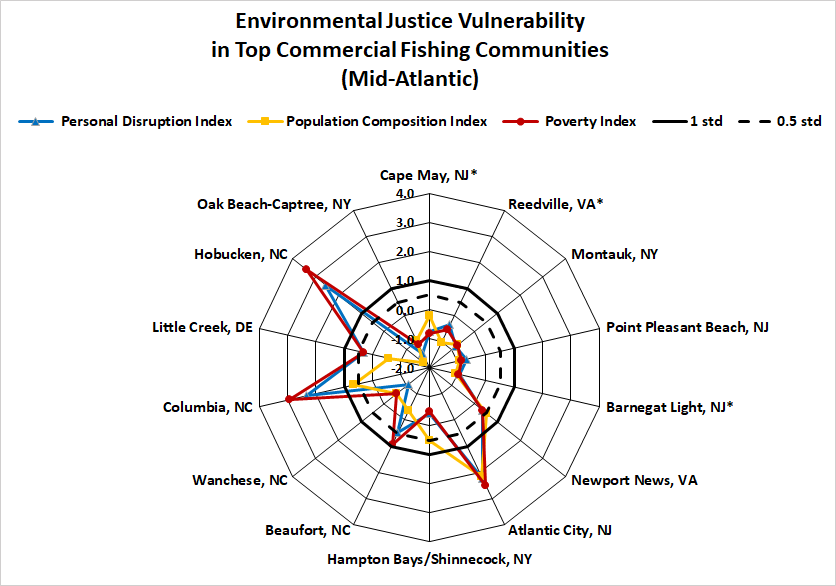--> ] Implications: Highlighted communities may be vulnerable to changes in fishing patterns due to regulations and/or climate change. When also experiencing environmental justice issues, they may have lower ability to successfully respond to change. ??? These plots provide a snapshot of the presence of environmental justice issues in the most highly engaged and most highly reliant commercial and recreational fishing communities in the Mid-Atlantic. These communities may be vulnerable to changes in fishing patterns due to regulations and/or climate change. When any of these communities are also experiencing social vulnerability including environmental justice issues, they may have lower ability to successfully respond to change. --- ## Objective: Environmental Justice and Social Vulnerability   Risk element: <span style="background-color:yellow;">Social</span>, unchanged Indicators: Environmental justice vulnerability, recreational fishery engagement and reliance .pull-left[ <img src="20220427_UM_MEES631_Gaichas_files/figure-html/unnamed-chunk-46-1.png" width="468" style="display: block; margin: auto;" /> Mid-Atlantic recreational fishing communities ] .pull-right[ <img src="20220427_UM_MEES631_Gaichas_files/figure-html/unnamed-chunk-47-1.png" width="100%" style="display: block; margin: auto;" /> <!--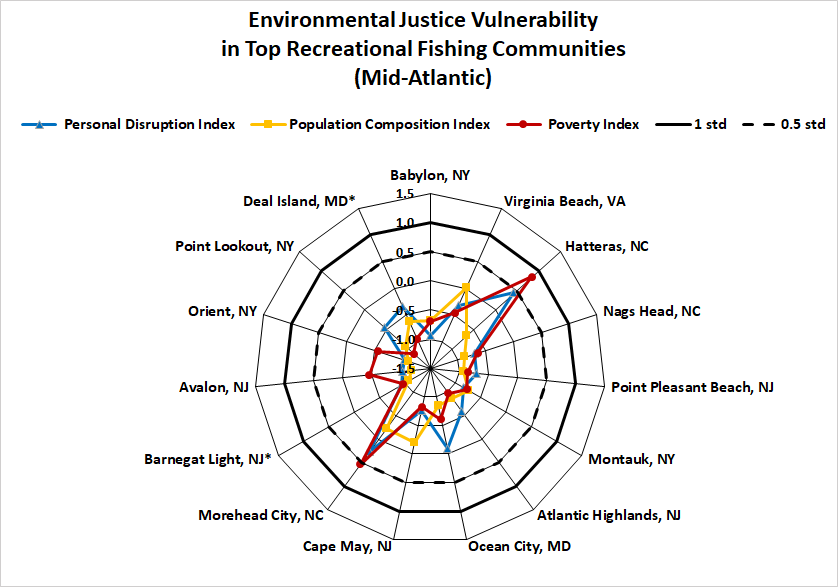--> ] Implications: Highlighted communities may be vulnerable to changes in fishing patterns due to regulations and/or climate change. When also experiencing environmental justice issues, they may have lower ability to successfully respond to change. --- ## Objectives: Protected species *Maintain bycatch below thresholds*   .pull-left[ Indicators: Harbor porpoise and gray seal bycatch .reduced_opacity[ <img src="20220427_UM_MEES631_Gaichas_files/figure-html/unnamed-chunk-48-1.png" width="504" style="display: block; margin: auto;" /> <img src="20220427_UM_MEES631_Gaichas_files/figure-html/unnamed-chunk-49-1.png" width="504" style="display: block; margin: auto;" /> ] ] .pull-right[ Implications: * Currently meeting objectives * Risk element: TechInteract, evaluated by species and sector: 14 <span style="background-color:lightgreen;">low</span>, 6 <span style="background-color:yellow;">low-mod</span>, 3 <span style="background-color:orange;">mod-high</span> risk, unchanged * The downward trend in harbor porpoise bycatch can also be due to a decrease in harbor porpoise abundance in US waters, reducing their overlap with fisheries, and a decrease in gillnet effort. * The increasing trend in gray seal bycatch may be related to an increase in the gray seal population (U.S. pup counts). ] --- ## Objectives: Protected species *Recover endangered populations*   .pull-left[ Indicators: North Atlantic right whale population, calf counts <img src="20220427_UM_MEES631_Gaichas_files/figure-html/unnamed-chunk-50-1.png" width="504" style="display: block; margin: auto;" /> <img src="20220427_UM_MEES631_Gaichas_files/figure-html/unnamed-chunk-51-1.png" width="504" style="display: block; margin: auto;" /> ] .pull-right[ Implications: * Population drivers for North Atlantic Right Whales (NARW) include combined fishery interactions/ship strikes, distribution shifts, and copepod availability. * Additional potential stressors include offshore wind development, which overlaps with important habitat areas used year-round by right whales, including mother and calf migration corridors and foraging habitat. * Unusual mortality events continue for 3 large whale species. <!--* Risk elements: - FW2Prey evaluated by species: 13 <span style="background-color:lightgreen;">low</span>, 3 <span style="background-color:yellow;">low-mod</span> risk, unchanged - TechInteract, evaluated by species and sector, unchanged--> ] --- ## Risks: Habitat climate vulnerability   New, opportunity to refine habitat risks Indicators: climate sensitive species life stages mapped to climate vulnerable habitats *See MAFMC 2022 EAFM risk assessment for example species narratives* <div id="htmlwidget-26b5826d42f761502450" style="width:100%;height:226.8px;" class="widgetframe html-widget"></div> <script type="application/json" data-for="htmlwidget-26b5826d42f761502450">{"x":{"url":"20220427_UM_MEES631_Gaichas_files/figure-html//widgets/widget_midHabTable.html","options":{"xdomain":"*","allowfullscreen":false,"lazyload":false}},"evals":[],"jsHooks":[]}</script> --- ## Risks: Offshore Wind Development   Element: OceanUse .pull-left[ Indicators: development timeline, fishery and community specific revenue in lease areas <img src="20220427_UM_MEES631_Gaichas_files/figure-html/unnamed-chunk-52-1.png" width="504" style="display: block; margin: auto;" /> <img src="20220427_UM_MEES631_Gaichas_files/figure-html/unnamed-chunk-53-1.png" width="504" style="display: block; margin: auto;" /> ] .pull-right[ <img src="20220427_UM_MEES631_Gaichas_files/figure-html/unnamed-chunk-54-1.png" width="504" style="display: block; margin: auto;" /> ] --- background-image: url("EDAB_images/offshore_wind_timeline.png") background-size: 500px background-position: right ## Risks: Offshore Wind Development   Element: OceanUse .pull-left[ Implications: * 1-31% of port revenue from fisheries currently comes from areas proposed for offshore wind development. Some communities have environmental justice concerns and gentrification vulnerability. * Up to 20% of annual commercial landings and revenue for Mid-Atlantic species occur in lease areas. * Development will affect species differently, negatively affecting species that prefer soft bottom habitat while potentially benefiting species that prefer hard structured habitat. * Planned wind areas overlap with one of the only known right whale foraging habitats, and altered local oceanography could affect right whale prey availability. Development also brings increased vessel strike risk and the potential impacts of pile driving noise. ] .pull-right[] ??? Current plans for rapid buildout of offshore wind in a patchwork of areas spreads the impacts differentially throughout the region Evaluating the impacts to scientific surveys has begun.